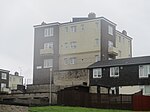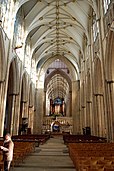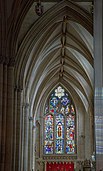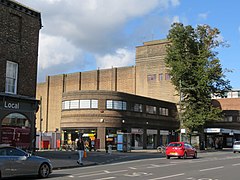York
| York | |
|---|---|
| City | |

Clockwise from the top left:
Micklegate Bar;
York Minsterfrom
the city walls;
Lendal Bridge; an aerial view of the city; and
the castle
|
|
|
Location within
North Yorkshire
|
|
| Area | 33.7 km2(13.0 sq mi) |
| Population | 141,685 (2021 census)[1] |
| •Density | 4,204/km2(10,890/sq mi) |
| Unitary authority | |
| Ceremonial county | |
| Region | |
| Country | England |
| Sovereign state | United Kingdom |
| Areas of the city |
List
|
| Post town | YORK |
| Postcode district | YO1, YO10, YO19, YO23-24, YO26, YO30-32, YO41 |
| Dialling code | 01904 |
| Police | North Yorkshire |
| Fire | North Yorkshire |
| Ambulance | Yorkshire |
| Website | york |
Yorkis acathedral cityinNorth Yorkshire,England, withRoman origins, sited at the confluence of the riversOuseandFoss. It is the county town ofYorkshire. The city has many historic buildings and other structures, such as aminster,castle, andcity walls. It is the largest settlement and the administrative centre of the widerCity of Yorkdistrict.
The city was founded under the name ofEboracumin 71 AD. It then became the capital of the Roman province ofBritannia Inferior, and later of the kingdoms ofDeira,Northumbria, andScandinavian York. In theMiddle Ages, it became thenorthern England ecclesiastical province's centre, and grew as a wool-trading centre.[2]In the 19th century, it became a major railway network hub and confectionery manufacturing centre. In theSecond World War, part of theBaedeker Blitzbombed the city. Although York was less targeted during the war than other, more industrialised northern cities, several historic buildings were gutted and restoration took place up until the 1960s.[3]
Historic governance of the city was as acounty corporate, not included in thecounty's riding system. The city has since been covered by amunicipal borough,county borough, and since 1996 anon-metropolitan district(the City of York), which also includes surrounding villages and rural areas, and the town ofHaxby. The current district'slocal councilis responsible for providing all local services and facilities throughout this area. York's built-up area had a population of 141,685 at the2021 UK census,[1]and the wider city (the local government district) had a population of 202,800, a 2.4% increase compared to the 2011 census.[4]
Toponymy
[edit]The city's name is derived fromBrittonicEburākon"place of yew trees", fromeburos"yew tree" (compareWelshefwr,Bretonevor, "alder, buckthorn";Old Irishibar,Irishiobhar,iubhar,iúr,Scottish Gaeliciubhar) +*-āko(n), a suffix ofappurtenancemeaning "belonging to", or "place of" (compare Welsh-og).[5]However,Eburos(Eβουρος,Eburus,Eburius) was also aCelticpersonal name, soEburākoncould also mean "the property of Eburos".[6][5]Indeed, the 12th‑century chroniclerGeoffrey of Monmouth, in his fictional account of the prehistoric kings of Britain,Historia Regum Britanniae, suggests the name derives from that of a pre-Roman city founded by the legendary kingEbraucus.[7]
The name wasLatinisedby theRomansasEboracumorEburacum, and is calledEabhraigin Scottish Gaelic andEabhracin Irish, derived from the Latin name. The LatinEboracumbecameAnglianEoforwicin the 7th century: a compound ofEofor-, from the old name, and-wic, meaning "village", probably by conflation of the elementEbor-with aGermanicroot*eburaz('boar'); by the 7th century, theOld Englishfor 'boar' had becomeeofor. When theDanisharmy conquered the city in 866, the name was rendered inOld NorseasJórvík.[8]
TheOld FrenchandNormanname of the city following theNorman Conquestwas recorded asEverwic(modern NormanÉvèroui) in works such as Wace'sRoman de Rouand asEuruicin theDomesday Book.[9][10]Jórvík, meanwhile, gradually reduced toYorkin the centuries after the Conquest, moving from theMiddle EnglishYerkin the 14th century throughYourkein the 16th century toYarkein the 17th century. The formYorkwas first recorded in the 13th century.[2][11]
Many company and place names, such as the Ebor race meeting, refer to the Roman name.[12]TheArchbishop of Yorksigns his surname asEbor(abbreviatingEboracensis).[13]
History
[edit]Early history
[edit]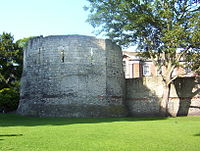
Archaeological evidence suggests thatMesolithicpeople settled in the region of York between 8000 and 7000 BC, although it is not known whether their settlements were permanent or temporary. By the time of theRoman conquest of Britain, the area was occupied by atribeknown to the Romans as theBrigantes. The Brigantian tribal area initially became a Roman client state, but later its leaders became more hostile and the RomanNinth Legionwas sent north of theHumberinto Brigantian territory.[14]
The city was founded in 71 AD, when the Ninth Legion conquered the Brigantes and constructed a wooden militaryfortresson flat ground above theRiver Ouseclose to itsconfluencewith theRiver Foss. The fortress, whose walls were rebuilt in stone by the VI legion based there subsequent to the IX legion, covered an area of 50 acres (20 ha) and was inhabited by 6,000legionarysoldiers. The site of theprincipia(HQ) of the fortress lies under the foundations ofYork Minster, and excavations in the undercroft have revealed part of the Roman structure and columns.[8][15]
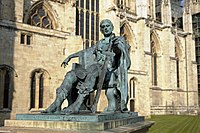
The EmperorsHadrian,Septimius Severus, andConstantius Iall held court in York during their various campaigns. During his stay 207–211 AD, the Emperor Severus proclaimed York capital of the province of Britannia Inferior, and it is likely that it was he who granted York the privileges of a 'colonia' or city. Constantius I died in 306 AD during his stay in York, and his sonConstantine the Greatwas proclaimed Emperor by the troops based in the fortress.[15][16]In 314 AD a bishop from York attended theCouncil at Arlesto represent Christians from theprovince.[17]
While the Romancoloniaandfortresswere on high ground, by 400 AD the town was victim to occasional flooding from the Rivers Ouse and Foss, and the population reduced.[18]York declined in thepost-Romanera, and was taken and settled by theAnglesin the 5th century.[19]
Reclamation of parts of the town was initiated in the 7th century underKing EdwinofNorthumbria, and York became his chief city.[20]The first woodenminster churchwas built in York for the baptism of Edwin in 627, according to the Venerable Bede.[21]Edwin ordered the small wooden church be rebuilt in stone; however, he was killed in 633, and the task of completing the stone minster fell to his successorOswald.[8][22]In the following century,Alcuin of Yorkcame to the cathedral school of York. He had a long career as a teacher and scholar, first at the school at York now known asSt Peter's School, founded in 627 AD, and later asCharlemagne's leading advisor on ecclesiastical and educational affairs.[23]
In 866, Northumbria was in the midst of internecine struggles when theVikingsraided and captured York. As a thriving Anglo-Saxon metropolis and prosperous economic hub, York was a clear target for the Vikings. Led byIvar the BonelessandHalfdan, Scandinavian forces attacked the town on All Saints' Day. Launching the assault on a holy day proved an effective tactical move – most of York's leaders were in the cathedral, leaving the town vulnerable to attack and unprepared for battle.
After it was conquered, the city was renamed from the Saxon Eoforwic toJorvik. It became the capital of Viking territory in Britain, and at its peak boasted more than 10,000 inhabitants. This was a population second only to London within Great Britain. Jorvik proved an important economic and trade centre for the Vikings. Norse coinage was created at the Jorvik mint, while archaeologists have found evidence of a variety of craft workshops around the town's centralCoppergatearea. These demonstrate that textile production, metalwork, carving, glasswork and jewellery-making were all practised in Jorvik. Materials from as far afield as thePersian Gulfhave also been discovered, suggesting that the town was part of an international trading network.[24]Under Viking rule the city became a major river port, part of the extensive Viking trading routes throughout northern Europe. The last ruler of an independent Jórvík,Eric Bloodaxe, was driven from the city in 954 AD by KingEadredin his successful attempt to complete the unification of England.[25]
After the conquest
[edit]
In 1068, two years after theNorman conquest of England, the people of York rebelled. Initially they succeeded, but upon the arrival ofWilliam the Conquerorthe rebellion was put down. William at once built a wooden fortress on a motte. In 1069, after another rebellion, the king built another timbered castle across the River Ouse. These were destroyed in 1069 and rebuilt by William about the time of his ravaging Northumbria in what is called the "Harrying of the North" where he destroyed everything from York to Durham. The remains of the rebuilt castles, now in stone, are visible on either side of the River Ouse.[26][27]
The first stone minster church was badly damaged by fire in the uprising, and the Normans built a minster on a new site. Around the year 1080,Archbishop Thomasstarted building the cathedral that in time became the current Minster.[22]
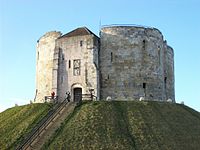
In the 12th century, York started to prosper. In 1190,York Castlewas the site of an infamousmassacre of its Jewish inhabitants, in which at least 150 were murdered, although some authorities put the figure as high as 500.[28][29]
The city, through its location on the River Ouse and its proximity to theGreat North Road, became a major trading centre.King Johngranted the city's firstcharterin 1212,[30]confirming trading rights in England and Europe.[22][31]During the later Middle Ages, York merchants imported wine from France, cloth, wax, canvas, and oats from theLow Countries, timber and furs from theBalticand exported grain toGasconyand grain and wool to the Low Countries.[32]
York became a major cloth manufacturing and trading centre.Edward Ifurther stimulated the city's economy by using the city as a base for his war in Scotland. The city was the location of significant unrest during the so-calledPeasants' Revoltin 1381. The city acquired an increasing degree of autonomy from central government including the privileges granted by a charter ofRichard IIin 1396.
16th to 18th centuries
[edit]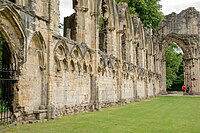
The city underwent a period of economic decline duringTudortimes. UnderKing Henry VIII, theDissolution of the Monasteriessaw the end of York's manymonastic houses, including several orders offriars, the hospitals of St Nicholas and of St Leonard, the largest such institution in the north of England. This led to thePilgrimage of Grace, an uprising of northern Catholics in Yorkshire and Lincolnshire opposed to religious reform. Henry VIII restored his authority by establishing theCouncil of the Northin York in the dissolved St Mary's Abbey. The city became a trading and service centre during this period.[33][34]King Henry VIII spent a lot of time travelling around the country on official Royal Tours also known as ‘progresses’[35]In the year 1541, Henry VIII and Catherine Howard visited the city of York on their royal tour. The Royal Party would have been met outside the walls by civic dignitaries before formally entering the city.[36]The civic dignitary would have been the Lord Mayor of york, who at the time of their arrival on 15 September 1541[37]was Robert Hall.[38]He owned the residential property at 74 Low Petergate. Following a special service held in their honour at York minster. Henry VIII and Catherine rode from the minster down to Petergate, one of the five gateways, and over to the closed Benedictine abbey of St. Mary[39]which had been converted into a palace for the King to stay in while he visited York on his Royal Tour.[40]
Anne of Denmarkcame to York with her childrenPrince HenryandPrincess Elizabethon 11 June 1603. The Mayor gave her a tour and offered herspiced wine, but she preferred beer.[41]Guy Fawkes, who was born and educated in York, was a member of a group ofRoman Catholicrestorationists that planned theGunpowder Plot.[42]Its aim was to displaceProtestantrule by blowing up theHouses of Parliamentwhile KingJames I, the entire Protestant, and even most of the Catholicaristocracyandnobilitywere inside.
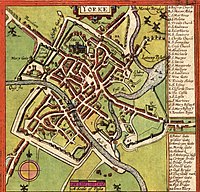
In 1644, during theCivil War, theParliamentariansbesieged York, and many medieval houses outside the city walls were lost. Thebarbicanat Walmgate Bar was undermined and explosives laid, but the plot was discovered. On the arrival ofPrince Rupert, with an army of 15,000 men, the siege was lifted. The Parliamentarians retreated some 6 miles (10 km) from York with Rupert in pursuit, before turning on his army and soundly defeating it at theBattle of Marston Moor. Of Rupert's 15,000 troops, 4,000 were killed and 1,500 captured. The siege was renewed and the city surrendered toSir Thomas Fairfax[33]on 15 July.
Following therestoration of the monarchyin 1660, and the removal of the garrison from York in 1688, the city was dominated by the gentry and merchants, although the clergy were still important. Competition fromLeedsandHull, together with silting of the River Ouse, resulted in York losing its pre-eminent position as a trading centre, but its role as the social and cultural centre for wealthy northerners was rising. York's many eleganttownhouses, such as theLord Mayor's Mansion HouseandFairfax Housedate from this period, as do theAssembly Rooms, theTheatre Royal, and theracecourse.[34][43]
Modern history
[edit]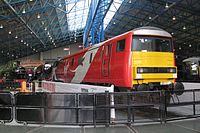
The railway promoterGeorge Hudsonwas responsible for bringing the railway to York in 1839. Although Hudson's career as a railway entrepreneur ended in disgrace and bankruptcy, his promotion of York over Leeds, and of his own railway company (theYork and North Midland Railway), helped establish York as a major railway centre by the late 19th century.[44]
The introduction of the railways established engineering in the city.[45][46]At the turn of the 20th century, the railway accommodated the headquarters and works of theNorth Eastern Railway, which employed more than 5,500 people. The railway was instrumental in the expansion ofRowntree's Cocoa Works. It was founded in 1862 by Henry Isaac Rowntree, who was joined in 1869 by his brother the philanthropistJoseph.[47]Another chocolate manufacturer,Terry's of York, was a major employer.[34][48]By 1900, the railways and confectionery had become the city's two major industries.[46]

York was a centre ofearly photography, as described by Hugh Murray in his 1986 bookPhotographs and Photographers of York: The Early Years, 1844–79. Photographers who had studios in York includedWilliam Hayes,William Pumphrey, andAugustus Mahalskiwho operated onDavygateandLow Petergatein the 19th century, having come to England as a refugee after serving as aPolish lancerin the Austro-Hungarian war.[49][50]
In 1942, the city was bombed during theSecond World War(part of theBaedeker Blitz) by the GermanLuftwaffeand 92 people were killed and hundreds injured.[51]Buildings damaged in the raid included theRailway Station,Rowntree'sFactory, Poppleton Road Primary School, St Martin-le-Grand Church, theBar Conventand theGuildhallwhich was left in total disrepair until 1960.

With the emergence of tourism, the historic core of York became one of the city's major assets, and in 1968 it was designated aconservation area.[52]The existing tourist attractions were supplemented by the establishment of theNational Railway Museumin York in 1975,[53]theJorvik Viking Centrein 1984[54]and theYork Dungeonin 1986.[55]The opening of theUniversity of Yorkin 1963 added to the prosperity of the city.[56]In March 2012,York's Chocolate Storyopened.[57]
York was voted European Tourism City of the Year by European Cities Marketing in June 2007, beating 130 other European cities to gain first place, surpassingGothenburgin Sweden (second) andValenciain Spain (third).[58]York was also voted safest place to visit in the 2010Condé Nast TravellerReaders' Choice Awards.[59]In 2018,The Sunday Timesdeemed York to be its overall 'Best Place to Live' in Britain, highlighting the city's "perfect mix of heritage and hi-tech" and as a "mini-metropolis with cool cafes, destination restaurants, innovative companies – plus the fastest internet in Britain".[60][61]The result was confirmed in aYouGovsurvey, reported in August 2018, with 92% of respondents saying that they liked the city, more than any of 56 other British cities.[62]
Governance
[edit]Local
[edit]|
|
This section needs to be
updated.
(July 2024)
|
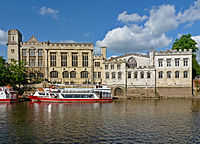
The City of York is governed by theCity of York Council. It is aunitary authoritythat operates on aleader and cabinetstyle of governance, having the powers of a non-metropolitan county and district council combined. It provides a full range of local government services including Council Tax billing, libraries, social services, processing planning applications, waste collection and disposal, and it is a local education authority. The city council consists of 47 councillors[63][64]representing 21wards, with one, two or three per ward serving four-year terms. Its headquarters are at theGuildhalland West Offices in the city centre.
York is divided into 21 administrative wards:Acomb,Bishopthorpe,Clifton,Copmanthorpe,DringhousesandWoodthorpe,Fishergate,FulfordandHeslington, Guildhall,HaxbyandWigginton,Heworth,Heworth Without,Holgate, Hull Road,HuntingtonandNew Earswick,Micklegate,OsbaldwickandDerwent,RawcliffeandClifton Without,Rural West York,Strensall,Westfield, andWheldrake.[65]
The members of the cabinet, led by theCouncil Leader, makes decisions on their portfolio areas individually.[66][67]Following theLocal Government Act 2000, the Council Leader commands theconfidenceof the city council; the leader of the largest political group and head of the City of York Council. The Leader of the council and the cabinet (consisting of all the executive councillors) are collectivelyaccountablefor their policies and actions to the city council. The current Council Leader,Liberal Democrats' Cllr Keith Aspden, was appointed on 22 May 2019, following the2019 City of York Council election.
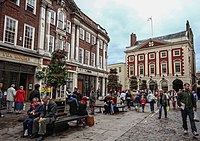
York's first citizen and civic head is theLord Mayor, who is thechairmanof the City of York Council. The appointment is made by the city council each year in May, at the same time appointing the Sheriff, the city's other civic head. The offices of Lord Mayor and Sheriff are purely ceremonial. The Lord Mayor carries out civic and ceremonial duties in addition to chairing full council meetings.[64]The incumbent Lord Mayor since 26 May 2022 is Councillor David Carr, and the Sheriff is Suzie Mercer.[68]
York Youth Council consists of several young people who negotiate with the councillors to get better facilities for York's young people, and who also elect York'sMember of Youth Parliament.[69][70]
The results of the2023 City of York Council electionsaw theConservative Partywith three councillors, the Liberal Democrats with 19 councillors, theLabour Partyhad 24 councillors and one Independent.[71]The council went fromno overall controlin the 2019 election, to being run by the Labour Party holding a majority.
| Party | Seats | City of York Council (2023 election) | |||||||||||||||||||||||||||||||||||||||||||||||||
|---|---|---|---|---|---|---|---|---|---|---|---|---|---|---|---|---|---|---|---|---|---|---|---|---|---|---|---|---|---|---|---|---|---|---|---|---|---|---|---|---|---|---|---|---|---|---|---|---|---|---|---|
| Conservative | 3 | ||||||||||||||||||||||||||||||||||||||||||||||||||
| Independent | 1 | ||||||||||||||||||||||||||||||||||||||||||||||||||
| Labour | 24 | ||||||||||||||||||||||||||||||||||||||||||||||||||
| Liberal Democrats | 19 | ||||||||||||||||||||||||||||||||||||||||||||||||||
York is the traditionalcounty townofYorkshire, and therefore did not form part of any of itsthree historic ridings, or divisions. Its Mayor has had the status of Lord Mayor since 1370,[72]one of 23 in England.[73]Only five of these have the title "The Right Honourable", the others being the Lord Mayors ofLondon,Bristol,CardiffandBelfast.[citation needed]York is an ancientborough, and was reformed by theMunicipal Corporations Act 1835to form amunicipal borough. It gained the status of acounty boroughin 1889, under theLocal Government Act 1888, and existed so until 1974, when, under theLocal Government Act 1972, it became anon-metropolitan districtin the county of North Yorkshire, whilst retaining its Lord Mayor and its Sheriff.[74][75]As a result of1990s UK local government reform, York regained unitary status and saw a substantial alteration in its borders, taking in parts ofSelbyandHarrogatedistricts, and about half the population of theRyedaledistrict.[76]The new boundary was imposed after central government rejected the former city council's own proposal.
Parliament
[edit]From 1997 to 2010, the central part of the district was covered by theCity of Yorkconstituency, while the remainder was split between the constituencies ofRyedale,Selby, andVale of York.[77]These constituencies were represented byHugh Bayley,John Greenway,John Grogan, andAnne McIntoshrespectively.
Following their review in 2003 of parliamentary representation inNorth Yorkshire, theBoundary Commission for Englandrecommended the creation of two new seats for the City of York, in time for thegeneral election in 2010. These areYork Central, which covers the inner urban area, and is entirely surrounded by theYork Outerconstituency.[78]
Ceremonial
[edit]York is within theceremonial countyofNorth Yorkshireand, until 1974, was within the jurisdiction of theLord Lieutenant of the County of York, West Riding and the County of The City of York. The city does retain the right to appoint its own Sheriff. The holder of theRoyaldukedom of Yorkhas no responsibilities either ceremonially or administratively as regards to the city.
Geography
[edit]Location
[edit]| Place | Distance | Direction | Relation |
|---|---|---|---|
| London | 280 km[79] | South-east | Capital |
| Lincoln | 90 km[80] | South-east | Next nearest historiccounty town |
| Middlesbrough | 70 km[81] | North | Largest place in the county |
| Ripon | 35 km[82] | North-west | Next nearest city |
| Leeds | 35 km[83] | South-west | Next nearest city |
York lies in theVale of York, a flat area of fertile arable land bordered by thePennines, theNorth York Moorsand theYorkshire Wolds. The city was built at the confluence of the Rivers Ouse and Foss on a terminalmoraineleft by thelast ice age.[84]
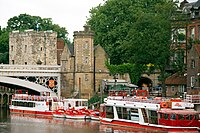
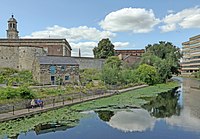
During Roman times, the land surrounding the Ouse and Foss was marshy, making the site easy to defend. The city is prone to flooding from the River Ouse, and has an extensive network of flood defences with walls along the river, and a liftable barrier across the Foss where it joins the Ouse at the "Blue Bridge". In October and November 2000, York experienced the worst flooding in 375 years; more than 300 homes were flooded.[85]In December 2015, the flooding was more extensive and caused major disruption.[86]The extreme impact led to a personal visit by Prime MinisterDavid Cameron.[87]Much land in and around the city is on flood plains too flood-prone for development other than agriculture. Theingsare flood meadows along the Ouse, while thestraysare open common grassland in various locations around the city.
Climate
[edit]York has atemperate climate(Cfb) with four distinct seasons. As with the rest of the Vale of York, the city's climate is drier and warmer than the rest of theYorkshire and the Humberregion. Owing to its lowland location, York is prone to frosts, fog, and cold winds during winter, spring, and very early summer.[88]Snow can fall in winter from December onwards to as late as April but quickly melts. As with much of the British Isles, the weather is changeable. York experiences most sunshine from May to July, an average of six hours per day.[89]With its inland location, summers are often warmer than the Yorkshire coast with temperatures of 27 °C or more. Extremes recorded at the University of York campus between 1998 and 2010 include a highest temperature of 34.5 °C (94.1 °F)[when?]and a lowest temperature of −16.3 °C (2.7 °F) on 6 December 2010. The most rainfall in one day was 88.4 millimetres (3.5 in).[90]
| Climate data forRAF Linton-on-Ouse, 15 km north-west of York | |||||||||||||
|---|---|---|---|---|---|---|---|---|---|---|---|---|---|
| Month | Jan | Feb | Mar | Apr | May | Jun | Jul | Aug | Sep | Oct | Nov | Dec | Year |
| Record high °C (°F) | 16 (61) |
18 (64) |
22 (72) |
28 (82) |
30 (86) |
32 (90) |
40.2 (104.4) |
34 (93) |
32 (90) |
29 (84) |
20 (68) |
17 (63) |
40.2 (104.4) |
| Mean daily maximum °C (°F) | 7.0 (44.6) |
7.5 (45.5) |
10.0 (50.0) |
13.0 (55.4) |
16.6 (61.9) |
19.5 (67.1) |
22.0 (71.6) |
22.0 (71.6) |
18.4 (65.1) |
13.9 (57.0) |
9.7 (49.5) |
7.0 (44.6) |
14.0 (57.2) |
| Mean daily minimum °C (°F) | 2.0 (35.6) |
1.0 (33.8) |
2.4 (36.3) |
4.0 (39.2) |
6.7 (44.1) |
9.7 (49.5) |
11.8 (53.2) |
11.6 (52.9) |
9.5 (49.1) |
7.0 (44.6) |
4.0 (39.2) |
2.0 (35.6) |
6.0 (42.8) |
| Record low °C (°F) | −16 (3) |
−10 (14) |
−13 (9) |
−3 (27) |
1 (34) |
2 (36) |
5 (41) |
5 (41) |
−1 (30) |
−4 (25) |
−8 (18) |
−16 (3) |
−16 (3) |
| Averageprecipitationmm (inches) | 52.7 (2.07) |
39.9 (1.57) |
44.9 (1.77) |
50.1 (1.97) |
43.8 (1.72) |
58.0 (2.28) |
53.2 (2.09) |
62.4 (2.46) |
46.9 (1.85) |
57.7 (2.27) |
57.8 (2.28) |
55.8 (2.20) |
626.0 (24.65) |
| Average precipitation days | 11.1 | 9.1 | 9.5 | 9.3 | 9.1 | 9.3 | 8.9 | 10.0 | 8.6 | 10.4 | 11.3 | 10.7 | 117.2 |
| Mean monthlysunshine hours | 40 | 60 | 100 | 141 | 190 | 220 | 230 | 205 | 156 | 105 | 65 | 47 | 1,550 |
| Source 1: Met Office[91] | |||||||||||||
| Source 2:BBC Weather[92] | |||||||||||||
Green belt
[edit]York's urbanised areas are surrounded by a green belt that restricts development in the rural areas and parts of surrounding villages,[93]to preserve the setting and historic character of the city.[94]The green belt surrounds nearly all of the city and its outer villages, extending out into North Yorkshire.
Demography
[edit]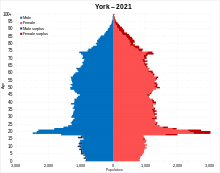
The Yorkurban area(built-up area) had a population of 153,717 at the time of the2011 UK census,[95]compared with 137,505 in 2001.[96]The population of theCity of York(Local Authority) was 198,051 and its ethnic composition was 94.3% White, 1.2% Mixed, 3.4% Asian and 0.6% Black. York's elderly population (those 65 and over) was 16.9%, however only 13.2% were listed as retired.[97]
|
|
This section needs to be
updated.
(November 2018)
|
Also at the time of the2001 UK census, the City of York had a total population of 181,094 of whom 93,957 were female and 87,137 were male. Of the 76,920 households in York, 36.0% were married couples living together, 31.3% were one-person households, 8.7% wereco-habitingcouples and 8.0% were lone parents. The figures for lone parent households were below the national average of 9.5%, and the percentage of married couples was also close to the national average of 36.5%; the proportion of one person households was slightly higher than the national average of 30.1%.[98]
In 2001, the population density was 4,368/km2(11,310/sq mi).[96]Of those aged 16–74 in York, 24.6% had no academic qualifications, a little lower than 28.9% in all of England. Of York's residents, 5.1% were born outside the United Kingdom, significantly lower than the national average of 9.2%.White Britishform 95% of the population; the largest single minority group was recorded as Asian, at 1.9% of the population.
The number of theft-from-a-vehicle offences and theft of a vehicle per 1,000 of the population was 8.8 and 2.7, compared to the English national average of 6.9 and 2.7 respectively.[99]The number of sexual offences was 0.9, in line with the national average.[99]The national average of violence against another person was 16.2 compared to the York average of 17.5.[99]The figures for crime statistics were all recorded during the 2006–07 financial year.
The city's estimated population in 2019 was 210,620.[100]
Population change
[edit]| Population growthin York since 1801 | |||||||||||||||||||||||
|---|---|---|---|---|---|---|---|---|---|---|---|---|---|---|---|---|---|---|---|---|---|---|---|
| Year | 1801 | 1811 | 1821 | 1831 | 1841 | 1851 | 1861 | 1871 | 1881 | 1891 | 1901 | 1911 | 1921 | 1931 | 1941[a] | 1951 | 1961 | 1971 | 1981 | 1991 | 2001[b] | 2011 | |
| Population | 24,080 | 27,486 | 30,913 | 36,340 | 40,337 | 49,899 | 58,632 | 67,364 | 76,097 | 81,802 | 90,665 | 100,487 | 106,278 | 112,402 | 123,227 | 135,093 | 144,585 | 154,749 | 158,170 | 172,847 | 181,131 | 198,051 | |
| Source:Vision of Britain[101] | |||||||||||||||||||||||
Ethnicity
[edit]| Ethnic Group | Year | |||||||
|---|---|---|---|---|---|---|---|---|
| 1991[102] | 2001[103] | 2011[104] | 2021[105] | |||||
| Number | % | Number | % | Number | % | Number | % | |
| White: Total | 165,118 | 99% | 177,191 | 97.8% | 186,731 | 94.2% | 188,167 | 92.8% |
| White:British | – | – | 172,237 | 95.1% | 178,613 | 90.1% | 176,963 | 87.3% |
| White:Irish | – | – | 1,217 | 1,103 | 1,317 | 0.6% | ||
| White:Gypsy or Irish Traveller | – | – | 269 | 368 | 0.2% | |||
| White: Roma | 222 | 0.1% | ||||||
| White:Other | – | – | 3,737 | 6,746 | 9,297 | 4.6% | ||
| Asian or Asian British: Total | 952 | 0.6% | 2,027 | 1.1% | 6,740 | 3.4% | 7,634 | 3.8% |
| Asian or Asian British:Indian | 237 | 542 | 1,531 | 1,853 | 0.9% | |||
| Asian or Asian British:Pakistani | 68 | 201 | 417 | 545 | 0.3% | |||
| Asian or Asian British:Bangladeshi | 133 | 364 | 370 | 413 | 0.2% | |||
| Asian or Asian British:Chinese | 318 | 642 | 2,449 | 2,889 | 1.4% | |||
| Asian or Asian British: Other Asian | 196 | 278 | 1,973 | 1,934 | 1.0% | |||
| Black or Black British: Total | 304 | 0.2% | 341 | 0.2% | 1,194 | 0.6% | 1,325 | 0.7% |
| Black or Black British:African | 113 | 164 | 903 | 978 | 0.5% | |||
| Black or Black British:Caribbean | 104 | 143 | 205 | 208 | 0.1% | |||
| Black or Black British:Other Black | 87 | 34 | 86 | 139 | 0.1% | |||
| Mixed or British Mixed: Total | – | – | 1,144 | 0.6% | 2,410 | 1.2% | 3,741 | 1.8% |
| Mixed: White and Black Caribbean | – | – | 248 | 529 | 631 | 0.3% | ||
| Mixed: White and Black African | – | – | 114 | 305 | 494 | 0.2% | ||
| Mixed: White and Asian | – | – | 456 | 873 | 1,579 | 0.8% | ||
| Mixed: Other Mixed | – | – | 326 | 703 | 1,037 | 0.5% | ||
| Other: Total | 439 | 0.2% | 973 | 1,954 | 1% | |||
| Other: Arab | – | – | 498 | 623 | 0.3% | |||
| Other: Any other ethnic group | 439 | 0.2% | 391 | 475 | 1,331 | 0.7% | ||
| Total | 166,813 | 100% | 181,094 | 100% | 198,051 | 100% | 202,821 | 100% |
Religion
[edit]Percentages in York following non-Christian religion were below England's national average. Classified as having "No Religion" is higher than the national average. Christianity has the largest religious following in York, 59.5% residents reported as Christian in the 2011 census.
York has multiple churches, most present churches in York are from the medieval period.St William's Collegebehind the Minster, andBedern Hall, offGoodramgate, are former dwelling places of thecanonsof the York Minster.[106]
There are 33 activeAnglicanchurches in York, which is home to theArchbishop of YorkandYork Minster, theMother Churchand administrative centre of thenorthern provinceof the Church of England and theDiocese of York.[107]York is in theRoman Catholic Diocese of Middlesbrough, has eight Roman Catholic churches and a number of different Catholic religious orders.[108]
Leaders of different Christian denominations work together across the city, forming a network of churches known as One Voice York.[109]Other Christian denominations active in York include theReligious Society of Friendswho have threemeeting houses,[110]Methodists(the York Circuit of The Methodist Church York and Hull District),[111]andUnitarians. St Columba'sUnited Reformed Churchin Priory Street, originally built for thePresbyterians, dates from 1879.[112]York's only Mosque is located in theLayerthorpearea, and the city also has aUK Islamic Missioncentre.[113]VariousBuddhisttraditions are represented in the city and around York.[114]There is also an active Jewish community.[115]
| Religion | 2001[116] | 2011[117] | 2021[118] | |||
|---|---|---|---|---|---|---|
| Number | % | Number | % | Number | % | |
| No religion | 30,003 | 16.6 | 59,646 | 30.1 | 93,577 | 46.1 |
| Holds religious beliefs | 137,377 | 75.9 | 123,009 | 62.1 | 95,314 | 47.0 |
| 134,771 | 74.4 | 117,856 | 59.5 | 89,019 | 43.9 | |
| 388 | 0.2 | 1,016 | 0.5 | 1,045 | 0.5 | |
| 347 | 0.2 | 983 | 0.5 | 1,043 | 0.5 | |
| 191 | 0.1 | 202 | 0.1 | 273 | 0.1 | |
| 1,047 | 0.6 | 2,072 | 1.0 | 2,488 | 1.2 | |
| 95 | 0.1 | 133 | 0.1 | 179 | 0.1 | |
| Other religion | 538 | 0.3 | 747 | 0.4 | 1,266 | 0.6 |
| Religion not stated | 13,714 | 7.6 | 15,396 | 7.8 | 13,930 | 6.9 |
| Total population | 181,094 | 100.0 | 198,051 | 100.0 | 202,821 | 100.0 |
Economy
[edit]Overview
[edit]
A July 2020 report by Council stated that York is worth "£5.2 billion to the UK economy ... with 9,000 businesses and 110,000 people employed across the city".[119]According toMake It York, the city benefits from features that include a well-educated workforce, "excellent transport links to both national and international markets, pronounced strengths in a range of high value sectors, a pioneering digital infrastructure, outstanding business support networks ...".[120]
York's economy is based on theservice industry, which in 2000 was responsible for 88.7% of employment in the city.[121]
Statistics based on 2019 data indicated that tourism was worth over £765 million to the city, supported 24,000 jobs and attracted 8.4 million visitors each year.[122]
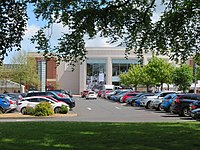
The Employment Rate in 2018 was 78.8%. The private sector accounted for 77,000 jobs in 2019 while 34,500 jobs were in the public sector.[100]
The service industries include public sector employment, health, education, finance, information technology (IT) and tourism that accounted for 10.7% of employment as of 2016. Tourism has become an important element of the economy, with the city offering a wealth of historic attractions, of whichYork Minsteris the most prominent, and a variety of cultural activities. As a holiday destination York was the 6th most visited English city by UK residents (2014–16)[123]and the 13th most visited by overseas visitors (2016).[124]A 2014 report, based on 2012 data,[125]stated that the city receives 6.9 million visitors annually; they contribute £564 million to the economy and support over 19,000 jobs.[126]In the 2017 Condé Nast Traveller survey of readers, York rated 12th among The 15 Best Cities in the UK for visitors.[127]In a 2020 Condé Nast Traveller report, York rated as the sixth best among ten "urban destinations [in the UK] that scored the highest marks when it comes to ... nightlife, restaurants, and friendliness".[128]
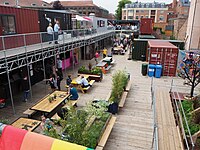
Unemployment in York was low at 4.2% in 2008 compared to the United Kingdom national average of 5.3%.[121]The biggest employer in York is the City of York Council, with over 7,500 employees. Employers with more than 2,000 staff includeAviva(formerly Norwich Union Life),Network Rail,Northern Trains, York Hospitals NHS Trust and theUniversity of York. Other major employers includeBT Group,CPP Group,Nestlé,NFU Mutualand a number of railway companies.[129][130]
A 2007 report stated that the economic position at that time very different from the 1950s, when its prosperity was based on chocolate manufacturing and the railways. This position continued until the early 1980s when 30% of the workforce were employed by just five employers and 75% of manufacturing jobs were in four companies.[131]Most industry around the railway has gone, including theYork Carriage Works, which at its height in the 1880s employed 5,500 people, but closed in the mid-1990s.[131][132]York is the headquarters of the confectionery manufacturer Nestlé York (formerly Nestlé Rowntrees) and home to theKitKatand eponymousYorkiebarchocolate brands.Terry'schocolate factory, makers of theChocolate Orange, was located in the city; but it closed on 30 September 2005, when production was moved by its owners,Kraft Foods, to Poland. The historic factory building is situated next to the Knavesmire racecourse.
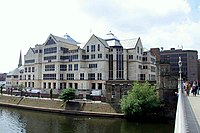
On 20 September 2006, Nestlé announced that it would cut 645 jobs at the Rowntree's chocolate factory in York.[133]This came after a number of other job losses in the city atAviva,British Sugar, andTerry's chocolate factory.[134]Despite this, the employment situation in York remained fairly buoyant until the effects of thelate 2000s recessionbegan to be felt.[135]
Since the closure of the carriage works, the site has been developed into offices. York's economy has been developing in the areas of science, technology and thecreative industries. The city became a founding National Science City with the creation of ascience parknear theUniversity of York.[136]Between 1998 and 2008, York gained 80 new technology companies and 2,800 new jobs in the sector.[137][138]
Effects of the COVID-19 pandemic
[edit]TheCOVID-19 pandemicwas confirmed to havereached Englandafter cases were discovered in York on 31 January 2020.[139][140]The pandemic caused an economic slowdown because of restrictions imposed on businesses and on travel in the UK; by January 2021, many cities were in their third lockdown and the country's unemployment rate had reached its highest level in over four years.[141][142]The retail, hospitality, and tourism sectors were especially hard hit in York.[143]In August 2020, the campaign "Make It York" and the city council embarked on a six-month tourism marketing plan "to reenergise the city while building resident and visitor confidence".[122]
A report in June 2020 stated that unemployment had risen 114% over the previous year because of restrictions imposed as a result of the pandemic.[144]In addition to high unemployment during lockdown periods, one analysis by the York and North Yorkshire Local Enterprise Partnership predicted in August 2020 that "as many as 13,835 jobs in York will be lost in the scenario considered most likely, taking the city's unemployment rate to 14.5%". Some critics claimed that part of the problem was caused by "over-reliance on the booming tourism industry at the expense of a long-term economic plan".[143]Other analyses suggested that "York is well-placed for the high street to recover and evolve from the pandemic if new businesses focus on creating an attraction or experience rather than traditional retail". The North Yorkshire Local Enterprise Partnership also "predicted a significant rise instaycationtrips to York in 2021".[145]
Public services
[edit]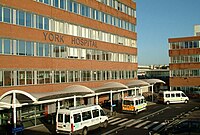
Under the requirements of theMunicipal Corporations Act 1835, York City Council appointed awatch committeewhich established a police force and appointed a chief constable.[146]On 1 June 1968 the York City, East Riding of Yorkshire, and North Riding of Yorkshire police forces were amalgamated to form theYork and North East Yorkshire Police. Since 1974,Home Officepolicing in York has been provided by theNorth Yorkshire Police. The force's central headquarters for policing York and nearbySelbyare in Fulford.[147]Statutory emergency fire and rescue serviceis provided by theNorth Yorkshire Fire and Rescue Service, based inNorthallerton.[148]
The city's first hospital,York County Hospital, opened in 1740 in Monkgate[149]funded by public subscription. It closed in 1976 when it was replaced byYork Hospital, which opened the same year and gainedFoundation statusin April 2007. It has 524 adult inpatient beds and 127 special purpose beds providing general healthcare and some specialist inpatient, daycase, and outpatient services.[150]It is also known as York District Hospital and YDH.[150]
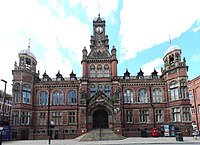
TheYorkshire Ambulance ServiceNHS Trust was formed on 1 July 2006 bringing together South Yorkshire Ambulance Service, West Yorkshire Metropolitan Ambulance Service and the North and East Yorkshire parts of Tees, East and North Yorkshire Ambulance Service to provide patient transport.[151]Other forms of health care are provided for locally by clinics and surgeries.
Since 1998,waste managementhas been co-ordinated via the York and North Yorkshire Waste Partnership.[152]York'sdistribution network operatorfor electricity isCE Electric UK;[153]there are nopower stationsin the city.Yorkshire Water, which has a local water extraction plant on theRiver Derwentat Elvington, manages York'sdrinkingandwaste water.[154]
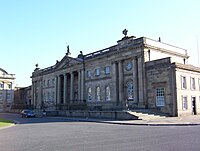
The city has amagistrates' court,[155]and venues for theCrown Court[156]and theCounty Court.[157]York Crown Courtwas designed by the architectJohn Carr, and built next to the then prison (including execution area).[158]
Between 1773 and 1777, the Grand Jury House was replaced by John Carr's elegant Court House for theAssizesof the whole county.The Female Prison was built opposite and mirrors the court building positioned around a circular lawn which became known as the "Eye of the Ridings", or the "Eye of York".
1776 saw the last recorded instance of a wife hanged and burnt for poisoning her husband.Horse theftwas acapital offence. The culprits of lesser crimes were brought to court by the city constables and would face a fine. The corporation employed a "common informer" whose task was to bring criminals to justice.[159]
The former prison is now theCastle Museumbut still contains the cells.
Transport
[edit]Water
[edit]York's location on the River Ouse, and in the centre of the Vale of York, means that it has always had a significant position in the nation's transport system.[32]The city grew up as a river port at the confluence of the Ouse and the Foss. The Ouse was originally atidal river, accessible to seagoing ships of the time. Today, both of these rivers remain navigable, although the Foss is only navigable for a short distance above the confluence. AlockatNaburnon the Ouse to the south of York means that the river in York is no longer tidal.[160]
Until the end of the 20th century, the Ouse was used bybargesto carry freight between York and theport ofHull. The last significant such traffic was the supply ofnewsprintto the local newspaper's Foss-side print works, which continued until 1997. Today, navigation is almost exclusively leisure-oriented.
Roads
[edit]
Like most cities founded by the Romans, York is well served by long-distance trunk roads. The city lies at the intersection of theA19 roadfromDoncastertoTyneside, theA59 roadfromLiverpoolto York, theA64 roadfromLeedstoScarboroughand theA1079 roadfrom York toHull. The A64 road provides the principal link to the motorway network, linking York to both theA1(M)and theM1 motorwaysat a distance of about 10 miles (15 km) from the city. The trans-PennineM62 motorwayis less than 20 miles (30 km) away providing links toManchesterand Liverpool. The city is surrounded on all sides by an outer ring road, at a distance of some 3 miles (5 km) from the centre of the city, which allows through traffic to by-pass the city. The street plan of the historic core of the city dates from medieval times and is not suitable for modern traffic. As a consequence, many of the routes inside the city walls are designated ascar-freeduring business hours or restrict traffic entirely. To alleviate this situation, six bus-basedpark and ridesites operate in York. The sites are located towards the edge of the urban area, with easy access from the ring road and allow out of town visitors to complete their journey into the city centre by bus.[161]
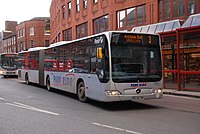
Public transport within the city is largely bus-based.First Yorkoperates the majority of the city's local bus services, as well as theYork park and rideservices. York was the location of the first implementation of FirstGroup's experimental and controversialFTR bus concept, which sought to confer the advantages of a modern tramway system at a lower cost.[162]The service was withdrawn following an election manifesto pledge by the Labour Group at the 2011 local government election.[163]Transdev Yorkalso operates a large number of local bus services. Open-top tourist and sightseeing buses are operated by Transdev York, on behalf ofCity Sightseeingand York Pullman on behalf ofGolden Tours.
Rural services, linking local towns and villages with York, are provided by a number of companies withTransdev York & Country,East YorkshireandReliance Motor Servicesoperating most of them.[164]Longer-distance bus services are provided by a number of operators, includingArriva Yorkshireservices to Selby,East Yorkshireservices to Hull, Beverley, Market Weighton and Pocklington, andTransdev York & Countryservices to Boroughbridge,Knaresborough, Harrogate,Castle Howardand Malton.Yorkshire CoastlinerlinksLeeds& York with Scarborough, Malton, Pickering andWhitby.[165]
Railway
[edit]
York has been a major railway centre since the first line arrived in 1839, at the beginning of the railway age. For many years, the city hosted the headquarters and works of theNorth Eastern Railway.[48]

Air
[edit]The closest international airports areLeeds Bradfordat 30 miles (48 km),Teesside47 miles (76 km),Doncaster Sheffield49 miles (79 km),Humberside54 miles (87 km). Further afield areManchester84 miles (135 km) andNewcastle95 miles (153 km).
Manchester Airport – with connections to Europe, North America, Africa and Asia – has direct rail links byTransPennine Expresswith itsnamesake station.[166]By road its accessible by theA64to theM60via theA1(M) motorway,M1andM62.
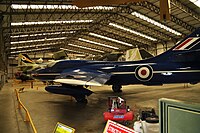
Teesside Airport has one connection viaDarlingtonandEaglescliffewith a limited service with a bus fromits stationto the airport. By road, it is accessible by theA19north to theA67. Newcastle Airport has one connection viaNewcastlewith the metro toNewcastle Airport, it is accessible by theA1(M)north to theA1then theA696.
Leeds Bradford and Humberside have no direct station with buses from the nearest stations. Leeds Bradford serves most major European and North African airports.[167]Humberside is accessible by theA1079to theA15via theA63; Leeds Bradford by theA59to theA658via theA661.[168]
York has an airfield at the formerRAF Elvington, 7 miles (11 km) south-east of the city centre, which is the home of theYorkshire Air Museumand used forprivate aviation. In 2003, plans were drafted to expand the site for business aviation or a full commercial service.[169]FormerRAF Church Fentonis also near the city and private, it is now calledLeeds East.
Education
[edit]Institutions
[edit]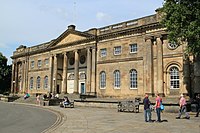

York Castle, a complex of buildings ranging from the medieval Clifford's Tower to the 20th-century entrance to theYork Castle Museum(formerly a prison) has had a chequered history. As well as the Castle Museum, the city contains numerous other museums and historic buildings such as theYorkshire Museumand itsMuseum Gardens,Jorvik Viking Centre,York Art Gallery,Merchant Adventurers' Hall, the reconstructed medieval houseBarley Hall(owned by theYork Archaeological Trust), the 18th-centuryFairfax House, theMansion House(the historic home of the Lord Mayor) and the so-calledTreasurer's House(owned by theNational Trust).[170]TheNational Railway Museumis situated just beyond the station, and is home to a vast range of transport material and the largest collection of railway locomotives in the world. Included in this collection are the world's fastest steam locomotiveLNER Class A4 4468Mallardand the world-famousLNER Class A3 4472Flying Scotsman, which has been overhauled in the Museum.[171]Although noted for its Medieval history, visitors can also gain an understanding of the Cold War through visiting theYork Cold War Bunker, former headquarters of No 20 Group of the Royal Observer Corps.[172]

The city's first subscription library opened in 1794.[173]The first freepublic library, theYork Library, was built onClifford Streetin 1893, to markQueen Victoria's jubilee. A new building was erected onMuseum Streetin 1927, and this is still the library today; it was extended in 1934 and 1938.[174]
Higher and further
[edit]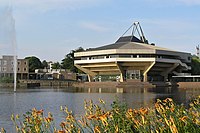
TheUniversity of York's main campus is on the southern edge of the city atHeslington. The Department of Archaeology and the graduate Centres for Eighteenth Century Studies and Medieval Studies are located in the historic King's Manor in the city centre.[175]
It was York's only institution with university status until 2006, when the more centrally locatedYork St John University, formerly an autonomous college of theUniversity of Leeds, attained full university status. The city formerly hosted a branch of theUniversity of Lawbefore it moved to Leeds. The University of York also has a medical school,Hull York Medical School.[176]
The city has two major further education institutions.York Collegeis an amalgamation of York Technical College and York Sixth Form College. Students there study a very wide range of academic and vocational courses, and range fromschool leaversandsixth formersto people training to make career moves.[177]Askham Bryan Collegeoffers further education courses, foundation and honours degrees, specialising in more vocational subjects such as horticulture, agriculture, animal management and evengolf coursemanagement.[178]
Secondary and primary
[edit]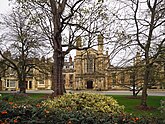
There are 70local councilschools with over 24,000 pupils in the City of York Council area.[179]The City of York Council manages most primary and secondary schools within the city.
|
|
This article needs to be
updated.
(July 2022)
|
Primary schools cover education from ages 5–11, with some offering early years education from age 3. From 11 to 16 education is provided by 10 secondary schools, four of which offer additional education up to the age of 18.[180]In 2007, Oaklands Sports College and Lowfield Comprehensive School merged to become one school known asYork High School.[181]
There is one "outstanding"[182]Roman Catholic secondary school in the city,All Saints School, which was founded in 1665, the school is split-site meaning that the education of lower years (years 7–9) happens on the Lower Site attached to the oldest running convent in the country,Bar Convent. And the upper years including sixth form are taught on the Upper Site which is on Mill Mount, the former site ofMill Mount County Grammar School for Girls. The Sixth form is the largest sixth form in the city. As a school it plays an essential role in York's Catholic community being the only secondary institution dedicated to the denomination. It was the first Catholic school in the country to admit girls for education in the 1660s.
York also has several private schools.St Peter's Schoolwas founded in 627. The scholarAlcuin, who went on to serveCharlemagne, taught there.[183]It was also the school attended byGuy Fawkes.[184]
Two schools haveQuakerorigins:Bootham Schoolisco-educational[185]andThe Mount Schoolis all-girls.[186]Another all-girls school isQueen Margaret's School, which was established under theWoodard Foundation.
Culture
[edit]The city is part of the UNESCOCreative Cities Networkas a city ofMedia Arts. An unsuccessful 2010 bid by York city council and a number of heritage organisations to make aUNESCOWorld Heritage Siteindirectly led to the city making a successful bid for its title.[187][188][189]
Theatre
[edit]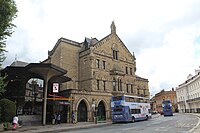
TheTheatre Royal, which was established in 1744, produces an annualpantomimewhich attracts loyal audiences from around the country. The theatre's veteran star,Berwick Kaler, often played thedame, before he retired from acting in the pantomime in 2019,[190]and officially parted ways with the theatre after the so-called "Panto Wars".[191]The Theatre Royal continues to produce an annual pantomime without Kaler, who came out of retirement in 2021 to star in a new panto at TheGrand Opera House.[192]Both the Grand Opera House and Joseph Rowntree Theatre also offer a variety of productions.[193][194]The city is home to theRiding Lights Theatre Company, which as well as operating a busy national touring department, also operates a busy youth theatre and educational departments. York is also home to a number of amateur dramatic groups.[195]The Department of Theatre, Film and Television and Student Societies of the University of York put on public drama performances.[196]
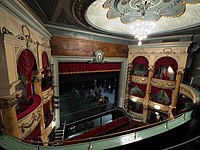
TheYork Mystery Playsare performed in public at intervals, using texts based on the original medieval plays of this type that were performed by the guilds – often with specific connections to the subject matter of each play. (For instance the Shipwrights' Play is theBuilding of Noah's Arkand the fish-sellers and mariners theLanding of Noah's Ark).[197]The York Cycle of Mystery Plays or Pageants is the most complete in England. Originally performed from wagons at various locations around the city from the 14th century until 1570, they were revived in 1951 during theFestival of Britain, when York was one of the cities with a regional festival.[198]They became part of the York City Festival every three years and later four years. They were mostly produced in a temporary open-air theatre within the ruins of St Mary's Abbey, using some professional but mostly amateur actors. Lead actors have includedChristopher TimothyandRobson Green(in the role of Christ) and DameJudi Denchas a school girl, in 1951, 1954 and 1957. (She remains a Patron of the plays). The cycle was presented in the Theatre Royal in 1992 and 1996, within York Minster in 2000 and in 2002, 2006 and 2010 by Guild groups from wagons in the squares, in theDean's Park, or at the Eye of York.[199]They go around the streets, recreating the original productions. In 2012, the York Mystery Plays were performed between 2 and 27 August atSt Mary's Abbeyin theYork Museum Gardens.[200]
Music
[edit]TheAcademy of St Olave's, achamber orchestrawhich gives concerts inSt Olave's Church, Marygate, is one of the music groups that perform regularly in York.[201]A former church,St Margaret's, Walmgate, is theNational Centre for Early Music, which hosts concerts, broadcasts, competitions and events including theYork Early Music Festival.[202][203]Students, staff and visiting artists ofYork St John Universitymusic department regularly perform lunchtime concerts in the university chapel. The staff and students of theUniversity of Yorkalso perform in the city.[204]
Food and drink
[edit]Each September since 1997, York has held an annual Festival of Food and Drink. The aim of the festival is to spotlight food culture in York and North Yorkshire by promoting local food production. The Festival attracts up to 150,000 visitors over 10 days from all over the country.[205]
The Assize of Ale is an annual event in the city where people in medieval costume take part in apub crawlto raise money for local charities. It has its origins in the 13th century, when anAssize of Bread and Alewas used to regulate the quality of goods. The current version was resurrected in 1990/91 by the then Sheriff of York, Peter Brown, and is led by the Guild of Scriveners.[206]

The Knavesmire, home of York Racecourse, plays host to Yorkshire's largest beer festival every September run by York CAMRA – York Beer & Cider Festival.[207]It is housed in a marquee opposite the grandstand of the racecourse in the enclosure and in 2016 offered over 450 real ales and over 100 ciders.[208]A product claimed to be local is York ham,[209]a mild-flavouredhamwith delicate pink colouring. It is traditionally served withMadeira Sauce.[210][211]The ham has been described as a lightly smoked, dry-cured ham that is saltier but milder in flavour than other European dry-cured hams.[212]Folklore has it that the oak construction for York Minster provided the sawdust for smoking the ham.[213]A likely apocryphal story attributes Robert Burrow Atkinson's butchery shop, inBlossom Street, to be the birthplace of the original York ham, or at least to have made it famous.[214]
Attractions
[edit]Architecture
[edit]York Minster, a largeGothiccathedral, dominates the city.
York's centre is enclosed bythe city's medieval walls, which are a popular walk.[215][216]These defences are the most complete in England. They have the only walls set on high ramparts and they retain all their principal gateways.[217]They incorporate part of the walls of the Roman fortress and some Norman and medieval work, as well as 19th- and 20th-century renovations.[218]
The entire circuit is approximately 2.5 miles (4 km), and encloses an area of 263 acres (106 ha).[219]The north-east section includes a part where walls never existed, because the Normanmoatof York Castle, formed by damming theRiver Foss, also created a lake which acted as a city defence. This lake was later called the King's Fishpond, as the rights to fish belonged to the Crown. A feature of central York is theSnickelways, narrow pedestrian routes, many of which led towards the former market-places inPavementandSt Sampson's Square.[220]The Shamblesis a narrowmedievalstreet, lined with shops, boutiques andtea rooms. Its unusual name comes from an old English term for an open-air slaughterhouse or meat market.[221]Most of these premises were once butchers' shops, and the hooks from which carcasses were hung and the shelves on which meat was laid out can still be seen outside some of them. The street also contains the Shrine ofMargaret Clitherow, although it is not located in the house where she lived.[222]Goodramgatehas many medieval houses including the early-14th‑centuryLady Rowbuilt to finance aChantry, at the edge of the churchyard ofHoly Trinity church.
-
The southern entrance to York, Micklegate Bar, is a 12th–14th century structure.
-
The Shamblesis a medieval shopping street; most of the buildings date from between c.1350 and 1475.
-
The Art Decostyle Odeon Cinema on Blossom Street
-
The 1960s Brutalist-style Stonebow House
Pubs
[edit]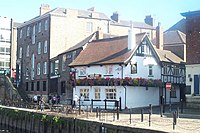
In June 2015, YorkCAMRAlisted 101 pubs on its map of the city centre, some of which are hundreds of years old.[223]These include theGolden Fleece,Ye Olde Starre Inne, noted for its sign which has spanned the street since 1733,[224]andThe Kings Arms, often photographed during floods.[225]On 18 June 2016, York CAMRA undertook a "Beer Census" and found 328 unique real ales being served in over 200 pubs in York, reinforcing the city's reputation as a top UK beer destination.[226]
Tea Rooms
[edit]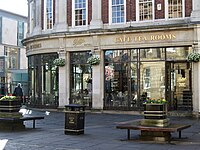
In the centre of York, inSt Helen's Square, there is the York branch ofBettys CaféTea Rooms. Bettys' founder, Frederick Belmont, travelled on the maiden voyage of theQueen Maryin 1936. He was so impressed by the splendour of the ship that he employed the Queen Mary's designers and craftsmen to turn a dilapidated furniture store in York into an elegant café in St Helen's Square. A few years after Bettys opened in York war broke out, and the basement 'Bettys Bar' became a favourite haunt of the thousands of airmen stationed around York. 'Bettys Mirror', on which many of them engraved their signatures with a diamond pen, remains on display today as a tribute to them.[227]
Media
[edit]
The York area is served by a local newspaper,The Press(known as theEvening Pressuntil April 2006),The York Advertisernewspaper (based atThe Presson Walmgate), and four local radio stations:BBC Radio York,YorkMix Radio,YO1 RadioandJorvik Radio. A local commercial radio station,Minster FM, broadcast until 2020 when it was replaced byGreatest Hits Radio York and North Yorkshire.[228][229][230][231][232][233]Another digital news and radio website isYorkMixrun by former print journalists, that incorporates Local News; What's On; Food & Drink; Things To Do and Business sections with articles written by residents and local journalists.[234]In August 2016 YorkMix was nominated in two categories in the O2 Media Awards for Yorkshire and The Humber.[235]
Local news and television programmes are provided byBBC YorkshireandBBC North East and Cumbriaon BBC One andITV YorkshireandITV Tyne Teeson ITV. Television signals are received from either theEmley MoororBilsdaletransmitters.[236][237]
On 27 November 2013, Ofcom awarded the 12-year local TV licence for the York area to a consortium entitled The York Channel, with the channel due to be on air in spring 2015.[238]This service is now on air asThat's TVNorth Yorkshire.[239]
York St John Universityhas a Film and Television Production department with links to many major industrial partners. The department hosts an annual festival of student work and a showcase of other regional films.[240]
TheUniversity of Yorkhas its own television stationYork Student Television(YSTV) and two campus newspapersNouseandYork Vision.[241]Its radio stationURYis the longest running legal independent radio station in the UK, and was voted Student Radio Station of the Year 2020 at theStudent Radio Awards.[242]
Sport
[edit]Football codes
[edit]
The city'sassociation footballteam isYork Citywho are competing in theNational Leagueas of the 2023–24 season. York have played as high as theold Second Divisionbut are best known for their 'giant killing' status in cup competitions, having reached theFA Cupsemi-final in1955and beatenManchester United3–0 during the 1995–96League Cup. Their matches are played at theYork Community Stadiumas of 2021,[243]having previously played atBootham Crescentsince 1932. The most notable footballers to come from York in recent years areLucy Staniforth,[244]Under-20 World Cupwinning captainLewis Cook[245]and formerEnglandmanagerSteve McClaren.[246]
York also has a strongrugby leaguehistory. York FC, later known asYork Wasps, formed in 1868, were one of the oldest rugby league clubs in the country but the effects of a move to the out of townHuntington Stadium, poor results and falling attendances led to their bankruptcy in 2002.[247]The supporters formed a new club,York City Knights, who played at the same stadium until 2015 when they moved toBootham Crescent. In 2021, they moved toYork Community Stadium.[248]In 2022, the club was renamed York RLFC[249]and as of 2023[update]the men's team (York Knights) play in TheChampionship[250]and the women's team (York Valkyrie) play in theSuper League.[251]There are three amateur rugby league teams in York; New Earswick All Blacks (inNew Earswick),York AcornandHeworth.York International 9swas an annualrugby league ninestournament which took place in York between 2002 and 2009.[252]Amateur sideYork Lokomotivecompete in theRugby League Conference.[citation needed]
Rugby unionhas been played in York since the 1860s, with multiple teams currently playing within the city.York RUFCwas formed in 1928, and amalgamated with theYork Cricket Clubin 1966. The teams' home ground is at York sports ground at Clifton Park. The men's 1st team play inNorth 1 East, with the women's team in RFUW Women's NC1 North East championship.[253]York Railway Institute (RI) RUFC home ground is at the York RI sports club on newlane, York. The men's team currently compete in Yorkshire Division 4 South East (Yorkshire 4), and the ladies team play in the RFUW Women's NC1 North East championship.[254]Based at the York site of chocolate and confectionery maker NestleRowntree's, Nestle Rowntree RUFC was founded originally in 1894 and re-founded in 1954. They currently play their home games atYork St. John UniversitySports Field and they compete in Yorkshire Division 4 South East (Yorkshire 4).[255]
Racing
[edit]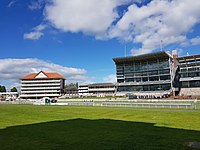
York Racecoursewas established in 1731 and from 1990 has been awarded Northern Racecourse of the Year for 17 years running. This majorhorseracingvenue is located on theKnavesmireand sees thousands flocking to the city every year for the 15 race meetings. The Knavesmire Racecourse also hostedRoyal Ascotin 2005.[256]In August, racing takes place over the four-dayEbor Festivalthat includes the Ebor Handicap dating from 1843.[257]
On 6 July 2014, York hosted the start of Stage 2 of the 2014Tour de France. Starting the Départ Fictif fromYork Racecourse, the riders travelled through the city centre to the Départ Actuel on the A59 just beyond the junction with the Outer Ring Road heading towardsKnaresborough.[258]In 2015, the inauguralTour de Yorkshirewas held as a legacy event to build on the popularity of the previous year, with the Day 2 stage finishing in York.[259]
Motorbike speedway once took place at York. The track in the Burnholme Estate was completed in 1930 and a demonstration event staged. In 1931 the track staged team and open events and the York team took part in the National Trophy.[260]
Other
[edit]An open rowing clubYork City Rowing Clubis located underneath Lendal Bridge.[261]The rowing clubs of The University of York,York St John University Rowing ClubandLeeds University Boat Clubas well as York City RC use the Ouse for training. There are two sailing clubs close to York, both of which sail dinghies on the River Ouse. The York RI (Railway Institute) Sailing Club has a club house and boat park on the outskirts ofBishopthorpe, a village3 miles (4.8 km) to the south of York. The Yorkshire Ouse Sailing Club has a club house in the village ofNaburn,5 miles (8.0 km) south of York.
York hosts theUK Snooker Championship, which is the second biggest ranking tournament in the sport, at theYork Barbican.
Garrison
[edit]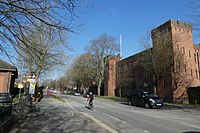
York Garrison is a garrison of the British army, which administers a number of units based in and around the city of York.[262][263][264][265]The garrison's current units are:[266]
- York Station
- Imphal Barracks
- Headquarters,1st (United Kingdom) Division
- 2 Signal Regiment,Royal Corps of Signals
- 12 Military Intelligence Company, 1 Military Intelligence Battalion
- 1 Investigation Company,Special Investigation Branch Regiment
- Kohima Troop, 50 (Northern) Signal Squadron,37 Signal Regiment[267]
- 3 Army Education Centre,Educational and Training Services Branch
- Worsley Barracks[268]
- Helmand Company,4th Battalion,Royal Yorkshire Regiment
- York Detachment,Leeds University Officers' Training Corps
- Yeomanry Barracks[269]
- A (Yorkshire Yeomanry) Squadron,Queen's Own Yeomanry
- Imphal Barracks
- Strensall Station
- Queen Elizabeth Barracks
- Headquarters,2nd Medical Brigade
- 34 Field Hospital,Royal Army Medical Corps
- Headquarters, Army Training Unit (North)
- 4th Infantry BrigadeCadet Training Team
- 1st (United Kingdom) Division Operational Shooting Training Team
- Towthorpe Lines
- Army Medical ServicesTraining Centre[270]
- Queen Elizabeth Barracks
International relations
[edit]Twin towns – sister cities
[edit]York istwinnedwith:
- Dijon,Bourgogne-Franche-Comté, France, since 1953[271]
- Münster,North Rhine-Westphalia, Germany, since 1957[271][272]
- Nanjing,Jiangsu, China, since 2016[273][274]
In 2016 York becamesister citieswith the Chinese city of Nanjing, in line with an agreement signed by theLord Mayor of York, focusing on building links in tourism, education, science, technology and culture.[273][274][275][276]
On 22 October 2014, it announced the first 'temporal twinning' with Jórvík, the Viking city on the site of York from 866 to 1066.[277]In 2017 York became UK's firsthuman rights city, which formalised the city's aim to use human rights in decision making.[278]
Freedom of the City
[edit]The following people and military units have received theFreedom of the Cityof York.
Individuals
[edit]- John Kendal: 1482.[279]
- John Moore: 29 September 1687.[279]
- Cosmo Gordon Lang: 1928.[280]
- Mary, Princess Royal and Countess of Harewood: 1952.[279]
- Edna Annie Crichton: 1955.[279]
- Prince Andrew, Duke of York: 23 February 1987[citation needed](revoked by aUnanimousvote of theCity of York Councilon 27 April 2022).[281]
- Sarah, Duchess of York: 23 February 1987.[282]
- Katharine, Duchess of Kent: April 1989.[279]
- John Barry: 2002.[279]
- Dame Judi Dench: 13 July 2002.[279][283]
- Berwick Kaler: 2003.[279]
- ProfessorSir Ronald Cooke: 2006.[279]
- Neal Guppy: 2010.[284]
Military units
[edit]- TheRoyal Dragoon Guards: 24 April 1999.[285]
- 2 Signals Regiment: January 2001.[286]
- A Squadron TheQueen's Own Yeomanry: 3 December 2009.[287]
- RAF Linton on Ouse: 19 September 2010.[288][289][290]
- TheQueen's Gurkha Signals: 8 September 2015.[291][292]
Notable people
[edit]See also
[edit]- Big Blue Ocean Cleanup
- CityConnect WIFI
- Evelyn collection
- Goddards House and Garden
- Rowntree Park
- Southlands Methodist Church
- White Rose Theatre
- York Festival of Ideas
- York Shakespeare Project
- Yorkshire dialect
Explanatory notes
[edit]- aThere was no census in 1941: figures are from National Register. United Kingdom and Isle of Man. Statistics of Population on 29 September 1939 by Sex, Age, and Marital Condition.
- bThere is a discrepancy of 37 between Office for National Statistics figures (quoted before) and those on the Vision of Britainwebsite (quoted here).
References
[edit]- ^ab"Figure 1: Explore population characteristics of individual BUAs"(XLS).Archivedfrom the original on 5 August 2023. Retrieved7 August2021.
- ^ab"Timeline". York Tourism Bureau. 2005. Archived fromthe originalon 8 January 2008. Retrieved25 October2007.
- ^"When sparks flew across the sky".The Press. Newsquest Media Group. 28 April 2012.Archivedfrom the original on 20 April 2019. Retrieved20 April2019.
- ^"How the population changed in York, Census 2021 – ONS".www.ons.gov.uk.Archivedfrom the original on 13 December 2022. Retrieved13 November2022.
- ^abXavier Delamarre,Dictionnaire de la langue gauloise, éditions errance 2003, p. 159.
- ^Pierre-Yves Lambert,La langue gauloise, éditions errance 1994, p. 39.
- ^Geoffrey of Monmouth (1136).Historia Regum Britanniae.Archivedfrom the original on 14 April 2016. Retrieved9 June2016– viaWikisource.
- ^abc"York's history". City of York Council. 20 December 2006. Archived fromthe originalon 31 October 2007. Retrieved1 October2007.
- ^Wace, Robert."Le Roman de Rou et des ducs de Normandie".BnF Gallica. p. 362.Archivedfrom the original on 9 November 2016. Retrieved15 September2016.
Li Barunz de Everwic Schire (the barons of Yorkshire)
- ^Mills, A. D. (2011).A Dictionary of British Place Names. Oxford University Press.doi:10.1093/acref/9780199609086.001.0001.ISBN9780191739446– via Oxford Reference.
- ^Willis, Ronald (1988).The illustrated portrait of York(4th ed.). Robert Hale Limited. p. 35.ISBN0-7090-3468-7.
- ^"Ebor Festival". York City of Festivals. Archived fromthe originalon 18 July 2011. Retrieved17 May2009.
- ^"How to address the Archbishops of Canterbury and York – Forms of Address, Church of England, Religion". Debretts.com. Archived fromthe originalon 21 January 2012. Retrieved4 December2011.
- ^Willis, Ronald (1988).The illustrated portrait of York(4th ed.). Robert Hale Limited. pp. 26–27.ISBN0-7090-3468-7.
- ^abShannon, John; Tilbrook, Richard (1990).York – the second city. Jarrold Publishing. p. 2.ISBN0-7117-0507-0.
- ^"Lower (Britannia Inferior) and Upper Britain (Britannia Superior)". Vanderbilt University.Archivedfrom the original on 2 March 2008. Retrieved24 October2007.
- ^Tillott, P. M., ed. (1961). "Before the Norman Conquest".A History of the County of York: the City of York. pp. 2–24.Archivedfrom the original on 19 April 2019. Retrieved19 April2019– via British History Online.
- ^Russo, Daniel G. (1998).Town Origins and Development in Early England, c. 400–950 A.D. Greenwood Publishing Group. pp. 119–120.ISBN978-0-313-30079-0.
- ^Jones, Barri; Mattingly, David (1990).An Atlas of Roman Britain. Cambridge: Blackwell Publishers (published 2007). p. 317.ISBN978-1-84217-067-0.Cemeteries that are identifiably Anglian date from this period; some graves are within the Roman cemetery on The Mount.
- ^"York history timeline". YorkHistory.com. 2007. Archived fromthe originalon 14 March 2007. Retrieved4 October2007.
- ^"The First Minster: History of York".History of York. York Museums Trust. Archived fromthe originalon 4 October 2011. Retrieved18 July2009.
- ^abc"York Minster: a very brief history". York Minster. Archived fromthe originalon 9 December 2012. Retrieved15 June2009.
- ^Ritchie, Anna (1 July 2001)."Alcuin of York". BBC.Archivedfrom the original on 31 August 2009. Retrieved18 July2009.
- ^"From the raid on Lindisfarne to Harald Hardrada's defeat: 8 Viking dates you need to know".History Extra. BBC.Archivedfrom the original on 16 June 2020. Retrieved16 June2020.
- ^"Jorvik: Viking York". City of York Council. 20 December 2006. Archived fromthe originalon 13 September 2007. Retrieved5 October2007.
- ^Chisholm, Hugh, ed. (1911)..Encyclopædia Britannica. Vol. 28 (11th ed.). Cambridge University Press. pp. 927–929.
- ^"The Old Baile".An Inventory of the Historical Monuments in City of York, Volume 2, the Defences. 1972. pp. 87–89.Archivedfrom the original on 27 February 2021. Retrieved16 June2020– via British History Online.
- ^"The 1190 Massacre".History Of York. York Museums Trust. Archived fromthe originalon 3 January 2013. Retrieved13 April2015.
- ^"Death in York". BBC. 28 September 2006.Archivedfrom the original on 14 December 2008. Retrieved10 October2007.
- ^"Charter Day celebrations for York announced".BBC News. 8 July 2011.Archivedfrom the original on 16 October 2015. Retrieved29 January2015.
- ^"Norman and Medieval York". City of York Council. 20 December 2006. Archived fromthe originalon 15 September 2007. Retrieved1 October2007.
- ^abTillott, P. M., ed. (1961).A History of the County of York: the City of York: The later middle ages – Communications, markets and merchants. British History Online. pp. 97–106.Archivedfrom the original on 12 January 2012. Retrieved18 July2009.
- ^ab"The Age of Decline". City of York Council. 20 December 2006. Archived fromthe originalon 4 February 2008. Retrieved5 October2007.
- ^abc"Post-medieval York".Secrets Beneath Your Feet. York Archaeological Trust. 1998. Archived fromthe originalon 17 May 2008. Retrieved18 July2009.
- ^"Research to shed new light on 'royal tours' of iconic King".York University.
- ^"Henry on Tour".henryontour.uk. Retrieved3 August2024.
- ^"St Mary's Abbey | York Museum Gardens".York museum gardens.
- ^Drake, Francis.A Catalogue of the Mayors and Bailiffs, Lord Mayors, and Sheriffs of the city of Your from anno 1273, 1 Edward I, and upwards, to the present year (1735).
- ^"Research to shed new light on 'royal tours' of iconic King".
- ^"St Mary's Abbey". York Museum Gardens. Retrieved3 August2024.
- ^Ethel Carleton Williams,Anne of Denmark(London, 1970), p. 77.
- ^"Transplanted Englishman brings country's Guy Fawkes party tradition to Burnsville".ThisWeek Online. ThisWeek Newspapers. 24 October 2007. Archived fromthe originalon 15 December 2005.
- ^"Georgian York – social capital of the North". City of York Council. 22 July 2008. Archived fromthe originalon 4 February 2008. Retrieved5 October2007.
- ^Sources:
- Unwin, R. W. (1980)."V. Leeds becomes a transport centre". In Fraser, Derek (ed.).A History of modern Leeds. Manchester University Press. pp. 132–133.ISBN0-7190-0747-X.Archivedfrom the original on 3 February 2016. Retrieved8 January2016.
- Armstrong, Alan (2005) [1974].Stability And Change in an English County Town: A Social Study of York 1801–51. Cambridge University Press. pp. 37–43.ISBN9780521019873.Archivedfrom the original on 3 February 2016. Retrieved8 January2016.
- Lewis, Stephen (3 July 2009)."East Coast Main Line: York's part in the history of the railways".York Press. Archived fromthe originalon 18 April 2012. Retrieved20 March2012.
- "George Hudson".SchoolNet. Spartacus Educational. Archived fromthe originalon 1 April 2009. Retrieved12 June2009.
- ^Rennison, Robert William (1996).Civil engineering heritage: Northern England. Thomas Telford. 5. York and North Yorkshire, pp.133.134.ISBN9780727725189.Archivedfrom the original on 3 February 2016. Retrieved8 January2016.
- ^ab"Industrialisation".www.historyofyork.org.uk. Archived fromthe originalon 25 October 2013. Retrieved30 November2013.
- ^"History of Nestlé Rowntree". Nestlé UK Ltd. 2008. Archived fromthe originalon 4 January 2008. Retrieved19 July2009.
- ^ab"The Railway Age to the present day". City of York Council. 20 December 2006. Archived fromthe originalon 16 May 2012.
- ^Murray, Jill."KNO/3/8: Transcript of 'Yorkshire Artists' by J W Knowles".explore York libraries and archives. pp. 112x, 113.Archivedfrom the original on 25 February 2021. Retrieved19 September2016.
- ^"Records of Augustus Mahalski, Photographer".Archives Hub. Archived fromthe originalon 19 September 2016. Retrieved19 September2016.
- ^"Luftwaffe pilot says sorry for bombing York".The Press. Newsquest Media Group. 17 April 2007.Archivedfrom the original on 12 January 2023. Retrieved21 July2009.
- ^"York Central Historic Core: Conservation Area Appraisal"(PDF). City of York Council.Archived(PDF)from the original on 18 November 2016. Retrieved17 November2016.
- ^"History of the NRM". National Railway Museum. Archived fromthe originalon 7 December 2009. Retrieved15 June2009.
- ^Renfrew, Colin; Bahn, Paul G. (2008).Archaeology: Theories, Methods and Practice(5 ed.). Thames & Hudson. p. 542.ISBN9780500287194.
- ^"York Dungeon celebrates 30th anniversary". York Press. 4 November 2016. Archived fromthe originalon 19 January 2018. Retrieved19 January2018.
- ^"Founding students return to York 40 years on". University of York. 7 October 2003. Archived fromthe originalon 9 November 2005. Retrieved15 June2009.
- ^"Inside York's new chocolate museum". York Press. 27 March 2012. Archived fromthe originalon 19 January 2018. Retrieved19 January2018.
- ^"York voted top city for tourists".BBC News. 14 June 2007.Archivedfrom the original on 7 January 2009. Retrieved28 July2008.
- ^"Conde Nast Traveller". Conde Nast Traveller. Archived fromthe originalon 17 October 2013. Retrieved22 May2014.
- ^"York — the best place to live in the UK 2018".The Sunday Times. 18 March 2018.Archivedfrom the original on 27 June 2018. Retrieved27 June2018.
- ^"This is the best place to live in the UK, according to a prestigious list".The Standard.Archivedfrom the original on 6 July 2018. Retrieved5 July2018.
- ^"YouGov – York is Britain's most popular city".YouGov: What the world thinks.Archivedfrom the original on 27 August 2018. Retrieved27 August2018.
- ^"Your councillors". City of York Council. Archived fromthe originalon 11 July 2009. Retrieved19 July2009.
- ^ab"The Constitution – Part 1 Summary and explanation"(PDF). City of York Council. Archived fromthe original(PDF)on 26 July 2011. Retrieved19 July2009.
- ^"City of York Council – wards". City of York Council. Archived fromthe originalon 21 November 2018. Retrieved20 November2018.
- ^"committee details – leisure culture and social inclusion". City of York Council. Archived fromthe originalon 26 July 2011. Retrieved10 May2010.
- ^"committee details – city strategy". City of York Council. Archived fromthe originalon 26 July 2011. Retrieved10 May2010.
- ^Cooper, Joe (26 May 2022)."New Lord Mayor of York David Carr pledges to help over cost of living".YorkMix. Archived fromthe originalon 22 May 2019. Retrieved27 May2022.
- ^"York Youth Council". York Youth Council. Archived fromthe originalon 15 February 2017. Retrieved15 February2017.
- ^"York teenagers to help improve bus services".York Press. 13 February 2016. Archived fromthe originalon 17 February 2017. Retrieved15 February2017.
- ^"City of York local elections May 2023". City of York Council. 5 May 2023. Retrieved17 July2024.
{{cite news}}: CS1 maint: url-status (link) - ^Maud Sellers (1897)."York in the Sixteenth and Seventeenth Centuries".The English Historical Review.12(47): 437–447.JSTOR548255– via JSTOR.
- ^"Lord Mayor's Office".www.birmingham.gov.uk. Birmingham City Council. Retrieved21 May2024.
- ^Bartholomew, John (1887)."Gazetteer of the British Isles entry for York".A Vision of Britain Through Time. Great Britain Historical GIS Project.Archivedfrom the original on 5 October 2007. Retrieved19 July2009.
- ^"Gazetteer of British Place Names – Map 2. Administrative counties and unitary authority areas". Association of British Counties. 10 September 2006. Archived fromthe originalon 22 July 2009. Retrieved17 May2009.
- ^The North Yorkshire (District of York) (Structural and Boundary Changes) Order. Stationery Office Books. 6 April 1995.ISBN978-0-11-052605-8.Archivedfrom the original on 19 April 2009. Retrieved17 May2009.
- ^"Your MPs". City of York Council. Archived fromthe originalon 9 May 2009. Retrieved19 July2009.
- ^"Final recommendations for Parliamentary constituencies in the County of North Yorkshire and the City of York". Boundary Commission for England. 5 November 2003. Archived fromthe original(Microsoft Word document)on 2 November 2009. Retrieved20 April2010.
- ^"Distance from City of London to York".Distance Calculator.Archivedfrom the original on 20 July 2022. Retrieved20 July2022.
- ^"Distance from York to Lincoln".Distance Calculator.Archivedfrom the original on 20 July 2022. Retrieved20 July2022.
- ^"Distance from York to Middlesbrough".Distance Calculator.Archivedfrom the original on 20 July 2022. Retrieved20 July2022.
- ^"Distance from York to Ripon".Distance Calculator.Archivedfrom the original on 12 January 2023. Retrieved8 May2022.
- ^"Distance from Leeds to York".Distance Calculator.Archivedfrom the original on 26 July 2022. Retrieved8 May2022.
- ^Hall, Richard (1996).English Heritage: Book of York(1st ed.). B.T.Batsford Ltd. p. 25.ISBN0-7134-7720-2.
- ^Dennis, Ian A.; Macklin, Mark G.; Coulthard, Tom J.; Brewer, Paul A. (2002)."The impact of the October–November 2000 floods on contaminant metal dispersal in the River Swale catchment, North Yorkshire, UK"(PDF). Wiley InterScience. p. 1. Archived fromthe original(PDF)on 29 November 2007. Retrieved20 April2019.
- ^"York floods: Hundreds evacuated and swathes of historic city underwater as rivers reach record levels".The Independent. 27 December 2015.Archivedfrom the original on 20 August 2016. Retrieved19 August2016.
- ^"Storm Frank: Jeremy Corbyn explains why he has only just turned up in the North – 'I didn't want to get in the way' – live".The Telegraph. 31 December 2015. Archived fromthe originalon 28 December 2015. Retrieved19 August2016.
- ^"England Rural Development Programme: Appendix A3 – Yorkshire and The Humber Region – Section 1 Description Of Current Situation In The Yorkshire And The Humber Region"(PDF). East Yorkshire Coastal Observatory. pp. 2–3.Archived(PDF)from the original on 6 June 2011. Retrieved15 June2009.
- ^"Average Conditions:York, United Kingdom".BBC Weather. Archived fromthe originalon 28 December 2008. Retrieved24 July2008.
- ^"Weather Pages". Department of Electronics, University of York.Archivedfrom the original on 11 May 2011. Retrieved27 May2011.
- ^"York climate".metoffice.gov.uk.Archivedfrom the original on 25 March 2015. Retrieved29 January2015.
- ^"Average Conditions – York, United Kingdom". BBC Weather. Archived fromthe originalon 12 August 2010. Retrieved8 March2010.
- ^Fawcett, Tony."Green Belts: A greener future – Campaign to Protect Rural England". Archived fromthe originalon 27 June 2018.
- ^"City of York Council download – The Development Control Local Plan (2005) and proposals maps| Planning and building – Planning policy".www.york.gov.uk. City of York Council.Archivedfrom the original on 28 January 2018.
- ^"2011 Census – Built-up areas".ONS.Archivedfrom the original on 21 September 2013. Retrieved15 August2013.
- ^ab"KS01 Usual resident population: Census 2001, Key Statistics for urban areas". Office for National Statistics. 17 June 2004.Archivedfrom the original on 16 March 2012. Retrieved11 March2012.
- ^UK Census(2011)."Local Area Report – York Local Authority (1946157112)".Nomis.Office for National Statistics. Retrieved7 February2018.
- ^"2001 Census: Key Statistics: Household Composition (KS20): Area: York (Local Authority)".Neighbourhood Statistics.Office for National Statistics. Archived fromthe originalon 13 June 2011. Retrieved19 May2009.
- ^abc"Crime figures for 2007/08 in York". UpMyStreet. Archived fromthe originalon 25 March 2010. Retrieved19 May2009.
- ^ab"York".Archivedfrom the original on 21 January 2021. Retrieved2 March2021.
- ^"York UA/City: Total Population".A Vision of Britain Through Time. Great Britain Historical GIS Project.Archivedfrom the original on 23 February 2012. Retrieved19 July2009.
- ^Data is taken from United KingdomCasweb Data servicesArchived15 December 2021 at theWayback Machineof the United Kingdom1991 Census on Ethnic Data for England, Scotland and WalesArchived5 April 2022 at theWayback Machine(Table 6)
- ^"Office of National Statistics; 2001 Census Key Statistics".UK Government Web Archive.Archivedfrom the original on 2 June 2022. Retrieved7 September2021.
- ^"2011 Census: Ethnic Group, local authorities in England and Wales".UK Government Web Archive.Archivedfrom the original on 8 August 2021. Retrieved15 December2021.
- ^"Ethnic group – Office for National Statistics".www.ons.gov.uk.Archivedfrom the original on 7 December 2022. Retrieved29 November2022.
- ^Sheahan, James Joseph; Whellan, T. (1857).History and Topography of the City of York, the East Riding of Yorkshire and a Portion of the West Riding. Vol. 1. p. 501.Archivedfrom the original on 12 January 2023. Retrieved12 June2009.
- ^Diocese of York Directory 2011/12. Diocese of York. 2011. pp. 187–200.
- ^"Parishes". Middlesbrough Diocese. 2007. Archived fromthe originalon 24 June 2008. Retrieved19 July2009.
- ^"Archbishop of York to maintain Easter baptisms tradition".York Press. Archived fromthe originalon 21 April 2017. Retrieved21 April2017.
- ^"Quakers in the York area". yorkquakers.org.uk. Archived fromthe originalon 8 September 2008. Retrieved19 July2009.
- ^"Circuits & Churches". The Methodist Church York and Hull District. Archived fromthe originalon 2 October 2011. Retrieved6 March2011.
- ^"St Columba's with New Lendal URC York".St Columba's York, United Reformed Church. yolasite.com. Archived fromthe originalon 9 March 2015. Retrieved29 January2015.
- ^"York Mosque and Islamic Centre – About Us". York Mosque. Archived fromthe originalon 18 August 2009. Retrieved15 June2009.
- ^"Buddhist organisations in York, NY, North-East areas".CommuniGate. This is Bradford. Archived fromthe originalon 10 December 2008. Retrieved19 July2009.
- ^Sherwood, Harriet."Eight centuries after the pogrom, pride flickers again in York's Jewish community".The Guardian.Archivedfrom the original on 12 April 2020. Retrieved12 April2020.
- ^"KS007 – Religion – Nomis – 2001".www.nomisweb.co.uk.Archivedfrom the original on 18 October 2022. Retrieved18 October2022.
- ^"KS209EW (Religion) – Nomis – 2011".www.nomisweb.co.uk.Archivedfrom the original on 18 October 2022. Retrieved18 October2022.
- ^"Religion – Office for National Statistics".Archivedfrom the original on 30 November 2022. Retrieved20 December2022.
- ^"Back York". City of York Council. Archived fromthe originalon 31 July 2021. Retrieved1 March2021.
- ^"A Place To Do Business". Make It York. Archived fromthe originalon 19 February 2021. Retrieved2 March2021.
- ^ab"Labour Market ProfileYork".Nomis.Office for National Statistics. Archived fromthe originalon 17 July 2011. Retrieved17 July2009.
- ^ab"York Marketing Strategy"(PDF). 13 August 2020. Archived fromthe original(PDF)on 20 October 2020. Retrieved2 March2021.
- ^"Most Visited Towns by Trip Purpose 2014–16 (Excel, 32KB)". Visit Britain. Archived fromthe originalon 4 January 2018. Retrieved4 January2018.
- ^"Inbound Town Data". Visit Britain. Archived fromthe originalon 23 December 2017. Retrieved4 January2018.
- ^"Tourists spend more than £600m".BBC News. 11 February 2014.Archivedfrom the original on 12 July 2018. Retrieved27 June2018.
- ^"Report"(PDF). VisitYork. Archived fromthe original(PDF)on 27 June 2018. Retrieved27 June2018.
- ^Traveller, Condé Nast."The best cities in the UK".www.cntraveller.com. Archived fromthe originalon 27 June 2018. Retrieved27 June2018.
- ^"The best cities in the UK 2020". Condé Nast Traveller. 7 October 2020.Archivedfrom the original on 7 March 2021. Retrieved2 March2021.
- ^"The Major Employers in the City of York Council area". City of York Council. 2011. Archived fromthe original(PDF)on 5 November 2013. Retrieved5 November2013.
- ^"University of York Profile 2009"(PDF). University of York. 2009. Archived fromthe original(PDF)on 17 January 2012. Retrieved3 August2009.
- ^ab"The Future York Group Report: An Independent Strategic Review of the York Economy"(PDF). The Future York Group Report. June 2007. Archived fromthe original(PDF)on 1 October 2011. Retrieved22 January2008.
- ^"Yet more railway jobs axed in York".The Press. Newsquest Media Group. 13 September 2006.Archivedfrom the original on 12 January 2023. Retrieved19 July2009.
- ^"More jobs lost at chocolate firm".BBC News. 20 September 2006.Archivedfrom the original on 15 February 2008. Retrieved19 July2009.
- ^"Job losses 'bitter blow' for city".BBC News. 14 September 2006.Archivedfrom the original on 13 March 2007. Retrieved19 July2009.
- ^"York reels from Norwich Union job cuts shock".York Press. Newsquest Media Group. 3 April 2009. Archived fromthe originalon 14 January 2013. Retrieved8 April2009.
- ^"Welcome to Science City York – 10 Years Promoting Innovation and Creativity". Science City York. Archived fromthe originalon 31 May 2009. Retrieved15 June2009.
- ^"About Science City York". Science City York. 2006. Archived fromthe originalon 4 August 2007. Retrieved19 January2008.
- ^"Regional Gross Value Added"(PDF). Office for National Statistics. 2005. pp. 240–253. Archived fromthe original(PDF)on 28 July 2011. Retrieved19 July2009.
- ^Ball, Tom; Wace, Charlotte (31 January 2020)."Hunt for contacts of coronavirus-stricken pair in York".The Times.ISSN0140-0460.Archivedfrom the original on 4 February 2020. Retrieved6 March2020.
- ^Moss, Peter; Barlow, Gavin; Easom, Nicholas; Lillie, Patrick; Samson, Anda (14 March 2020)."Lessons for managing high-consequence infections from first COVID-19 cases in the UK".The Lancet.395(10227): e46.doi:10.1016/S0140-6736(20)30463-3.ISSN0140-6736.PMC7133597.PMID32113507.Archivedfrom the original on 31 March 2020.
- ^"Labour market update: what does the third lockdown mean for the largest cities and towns?". 25 February 2021.Archivedfrom the original on 10 March 2021. Retrieved2 March2021.
- ^"Unemployment rate soars to highest level for more than four years".The Yorkshire Post.Archivedfrom the original on 26 January 2021. Retrieved2 March2021.
- ^abHalliday, Josh (2 August 2020)."'No one expected this': York at crossroads as coronavirus takes toll".The Guardian.Archivedfrom the original on 28 December 2020. Retrieved2 March2021.
- ^"'Toughest time in living memory' – unemployment up 141 in York".York Press.Archivedfrom the original on 1 August 2021. Retrieved2 March2021.
- ^"'Good news' for York as empty shops in city centre are being bought by local investors".The Yorkshire Post.Archivedfrom the original on 7 January 2021. Retrieved2 March2021.
- ^Tillott, P. M., ed. (1961).A History of the County of York: the City of York: Public services. British History Online. pp. 460–472.Archivedfrom the original on 13 February 2009. Retrieved20 September2009.
- ^"North Yorkshire Police : Central Area Commander – Chief Superintendent Ali Higgins". North Yorkshire Police. Retrieved20 July2009.[dead link]
- ^"Welcome to the website of North Yorkshire Fire & Rescue Service". North Yorkshire fire and Rescue Service. Archived fromthe originalon 15 June 2009. Retrieved18 May2009.
- ^"York County Hospital". York History. Archived fromthe originalon 24 August 2010. Retrieved16 March2016.
- ^ab"York Hospital – About our hospital". National Health Service.Archivedfrom the original on 4 May 2009. Retrieved18 May2009.
- ^"About Us – Yorkshire Ambulance Service NHS Trust". Yorkshire Ambulance Service. Archived fromthe originalon 18 May 2009. Retrieved18 May2009.
- ^"History". The York and North Yorkshire Waste Partnership. Archived fromthe originalon 20 May 2009. Retrieved18 May2009.
- ^"Welcome – CE Electric UK". CE Electric UK. Archived fromthe originalon 8 July 2009. Retrieved18 May2009.
- ^"Your water services". Yorkshire Water. Archived fromthe originalon 15 May 2009. Retrieved18 May2009.
- ^"Her Majesty's Courts Service – York Magistrates' Court". Her Majesty's Courts Service. Archived fromthe originalon 10 June 2007. Retrieved17 May2009.
- ^"Crown Court Directory – York". CourtServe Legal Information Centre. Archived fromthe originalon 25 May 2013. Retrieved24 April2012.
- ^"County Court Directory – York". CourtServe Legal Information Centre. Archived fromthe originalon 25 May 2013. Retrieved24 April2012.
- ^"John Carr – Architect: History of York". York Museums Trust. Archived fromthe originalon 4 October 2011. Retrieved17 May2009.
- ^"The County Court House". York Museums Trust. Archived fromthe originalon 17 April 2014. Retrieved30 June2013.
- ^"River Ouse". Canal & River Trust. Archived fromthe originalon 8 September 2013. Retrieved23 July2013.
- ^"Park & Ride". City of York Council. 31 August 2007. Archived fromthe originalon 14 October 2007. Retrieved9 October2007.
- ^"ftr – York's new public transport scheme". City of York Council. 22 May 2008. Archived fromthe originalon 28 June 2008. Retrieved20 July2009.
- ^"Controversial ftr buses make their final journey in York".York Press. 13 March 2012. Archived fromthe originalon 20 May 2012. Retrieved12 December2012.
- ^"Bus companies operating in York". City of York Council. 9 June 2009. Archived fromthe originalon 7 December 2008. Retrieved20 July2009.
- ^"History of the Yorkshire Coastliner – Linking Leeds and York with the Coast".Yorkshire Coastliner. Archived fromthe originalon 31 March 2009. Retrieved17 May2009.
- ^abc"Trains". City of York Council. 31 August 2007. Archived fromthe originalon 19 October 2007. Retrieved9 October2007.
- ^"Welcome to YorkAirLink.com".First York. Archived fromthe originalon 27 August 2008. Retrieved20 September2009.
- ^"York Airports". 19 August 2016.Archivedfrom the original on 26 January 2022. Retrieved26 January2022.
- ^"Up in the air for Elvington".The Press. Newsquest Media Group. 9 October 2003. Archived fromthe originalon 22 January 2018. Retrieved22 January2018.
- ^"York – Museums & Art Galleries". Tourist Net UK Ltd. Archived fromthe originalon 6 September 2009. Retrieved12 June2009.
- ^"About Flying Scotsman". National Railway Museum. Archived fromthe originalon 25 February 2009. Retrieved3 September2007.
- ^"York Cold War Bunker". English Heritage.Archivedfrom the original on 15 January 2014. Retrieved19 January2014.
- ^"York History – York Public Library". York History. Archived fromthe originalon 11 April 2011. Retrieved24 January2011.
- ^"York Central Library". History of York. 23 September 1927. Archived fromthe originalon 24 December 2015. Retrieved23 December2015.
- ^"The University of York". University of York.Archivedfrom the original on 26 April 2009. Retrieved19 May2009.
- ^"Guardian Medical school ranking tables".Guardian Education. London: Guardian News and Media Limited. 2009.Archivedfrom the original on 4 March 2009. Retrieved17 July2009.
- ^"About the new college". York College. Archived fromthe originalon 3 April 2009. Retrieved19 May2009.
- ^"Welcome to Askham Bryan College". Askham Bryan College.Archivedfrom the original on 22 March 2009. Retrieved19 May2009.
- ^"Schools and colleges". City of York Council. 4 February 2009. Archived fromthe originalon 19 September 2009. Retrieved17 June2009.
- ^"Secondary schools in York". City of York Council. 1 February 2007. Archived fromthe originalon 6 December 2008. Retrieved17 June2009.
- ^"£10m merger unveiled as 'York High School'".The Press. Newsquest Media Group. 28 September 2006.Archivedfrom the original on 12 January 2023. Retrieved19 May2009.
- ^Ofsted Communications Team (25 July 2022)."Find an inspection report and registered childcare".reports.ofsted.gov.uk.Archivedfrom the original on 13 September 2018. Retrieved21 November2022.
- ^"Catholic Encyclopedia: Alcuin". New Advent.Archivedfrom the original on 17 March 2009. Retrieved1 May2009.
- ^"Guy Fawkes History". St Peter's School Archives. Archived fromthe originalon 19 April 2008. Retrieved1 May2009.
- ^"The School and its Ethos". Bootham School York. Archived fromthe originalon 18 April 2009. Retrieved19 May2009.
- ^"Welcome to The Mount School York". The Mount School York. Archived fromthe originalon 23 March 2009. Retrieved19 May2009.
- ^"York submits bid for World Heritage status".BBC News. 11 June 2010.Archivedfrom the original on 25 September 2015. Retrieved2 June2014.
- ^"York World Heritage Site bid fails".BBC News. 22 March 2011.Archivedfrom the original on 16 October 2015. Retrieved2 June2014.
- ^"City bids for Unesco Media Arts recognition".Yorkshire Post. 22 November 2013.Archivedfrom the original on 5 June 2014. Retrieved2 June2014.
"York celebrates securing UNESCO City of Media Arts accolade".UNESCO. UK National Commission for UNESCO. 1 December 2014. Archived fromthe originalon 12 May 2015. Retrieved15 May2015. - ^""If the theatre needs me, I'll be back like a shot," says departing dame Berwick".York Press. 3 February 2019.Archivedfrom the original on 25 January 2022. Retrieved25 January2022.
- ^"Axed after 41 years: 'Devastated' panto stars told they won't be back at York Theatre Royal".YorkMix. 12 January 2020.Archivedfrom the original on 25 January 2022. Retrieved25 January2022.
- ^"This is what Berwick Kaler told the audience at the last night of the panto".YorkMix. 10 January 2022.Archivedfrom the original on 24 January 2022. Retrieved25 January2022.
- ^"What's on Grand Opera House York". Grand Opera House York. Archived fromthe originalon 2 March 2009. Retrieved15 June2009.
- ^"About Joseph Rowntree Theatre". Joseph Rowntree Theatre Limited. Archived fromthe originalon 2 March 2009. Retrieved15 June2009.
- ^"About Riding Lights". Riding Lights Theatre Company. Archived fromthe originalon 2 July 2009. Retrieved15 June2009.
- ^"Department of Theatre, Film and Television – The University of York". Department of Theatre, Film and Television, University of York. Archived fromthe originalon 19 April 2009. Retrieved15 June2009.
- ^J S Purvis,The York Cycle of Mystery Plays,London S.P.C.K. 1957 repr.1962
- ^"NCEM Archive". Archived fromthe originalon 1 July 2012. Retrieved26 June2012.
- ^"Guilds of York". Archived fromthe originalon 29 February 2012. Retrieved26 June2012.
- ^"York Mystery Plays 2012". Archived fromthe originalon 15 March 2012. Retrieved13 March2012.
- ^"Academy of St. Olave's Orchestra – Welcome". Academy of St Olave's. 2008. Archived fromthe originalon 29 November 2010. Retrieved17 June2009.
- ^"The National Centre for Early Music, York: Welcome". The National Centre for Early Music.Archivedfrom the original on 6 November 2012. Retrieved26 June2012.
- ^"York Early Music Festival: Overview". The National Centre for Early Music. Archived fromthe originalon 29 June 2012. Retrieved26 June2012.
- ^"University of York Concerts". University of York. Archived fromthe originalon 30 April 2009. Retrieved17 June2009.
- ^"York Festival of Food and Drink – Who we are and what we do". York Food Festival Ltd. Archived fromthe originalon 24 October 2009. Retrieved15 June2009.
- ^"Sheriff of York to test York's beers in traditional Assize of Ale".York Press. 13 August 2010. Archived fromthe originalon 15 September 2016. Retrieved30 June2016.
- ^"York Beer & Cider Festival is back and in a new exciting location". York Beer & Cider Festival. Archived fromthe originalon 15 August 2016. Retrieved19 August2016.
- ^"Tickets go on sale for York Beer and Cider Festival".The Press. 23 July 2016. Archived fromthe originalon 23 September 2016. Retrieved19 August2016.
- ^"Food Legends of the United Kingdom: York Ham". Information Britain. Archived fromthe originalon 13 June 2011. Retrieved11 November2009.
- ^"Home Cooking – Ham Varieties and Terminology".About.com. The New York Times Company. 16 September 2008. Archived fromthe originalon 6 October 2008. Retrieved5 October2008.
- ^"Recipe Favourites York ham and other recipes related to York ham". Recipe Tips.Archivedfrom the original on 13 January 2009. Retrieved5 October2008.
- ^Alden, Lori."Cook's Thesaurus: Ham". Food Subs.Archivedfrom the original on 16 October 2008. Retrieved5 October2008.
- ^"Hooray for Festive Ham".Country Life. 25 November 2008.Archivedfrom the original on 22 October 2021. Retrieved23 June2021.
- ^"History of 57 & 59 Blossom Street". Oliver's of the Mount. Archived fromthe originalon 8 November 2008. Retrieved5 October2008.
- ^"The city walls". City of York Council. 19 March 2012. Archived fromthe originalon 31 May 2012. Retrieved19 March2012.
- ^"York City Walls Walk Map".Walks in Yorkshire. Archived fromthe originalon 26 September 2017.
- ^Wilson, Barbara; Mee, Frances (2005).The City Walls and Castles of York: The Pictorial Evidence.York Archaeological Trust. p. ix.ISBN978-1-874454-36-6.
- ^Pevsner, Nikolaus; Neave, David (1995) [1972].Yorkshire: York and the East Riding(2nd ed.). London: Penguin Books. p. 192.ISBN0-14-071061-2.
- ^Wilson & Mee 2005, p. 1
- ^Jones, Mark W.; et al. (31 January 2004).A Walk Around the Snickelways of York. Dales Court Press.ISBN978-1-871125-72-6.
- ^"The Most Romantic Things to Do in York for Couples".Backpacking Bella. 5 April 2021.Archivedfrom the original on 18 October 2021. Retrieved18 October2021.
- ^"The Shambles, York UK". Inside York. Archived fromthe originalon 30 January 2009. Retrieved12 June2009.
- ^"York Real Ale Pub Map 2015"(PDF).yorkcamra.org.uk. Archived fromthe original(PDF)on 29 April 2016. Retrieved30 June2016.
- ^"'Houses: Stonegate', in An Inventory of the Historical Monuments in City of York, Volume 5, Central (London, 1981), pp. 220–235".www.britishhistory.ac.uk.Archivedfrom the original on 19 June 2016. Retrieved30 June2016.
- ^"The January Floods in York (1982)".www.yorkshirefilmarchive.com. Archived fromthe originalon 23 September 2016. Retrieved30 June2016.
- ^"York Beer Census 18 June 2016". York Campaign for Real Ale. 18 June 2016. Archived fromthe originalon 5 August 2016. Retrieved21 August2016.
- ^"Bettys Café Tea Rooms, York". Bettys & Taylors of Harrogate Limited. Archived fromthe originalon 3 December 2017. Retrieved2 December2017.
- ^"Most of acquired Bauer stations to become Greatest Hits Radio". 27 May 2020.Archivedfrom the original on 26 June 2022. Retrieved2 July2022.
- ^"York news, North Yorkshire news and information fromThe Pressnewspaper in York".The Press. Newsquest Media Group. Archived fromthe originalon 29 June 2009. Retrieved12 June2009.
- ^"Events in York, Visit York, Local News Yorkshire, Things to Do in York – Oneandother.com – York". Oneandother.com. 26 November 2011. Archived fromthe originalon 1 December 2011. Retrieved4 December2011.
- ^"Minster FM – Welcome".Minster FM. The Local Radio Company. Archived fromthe originalon 30 June 2009. Retrieved12 June2009.
- ^"On the air, hear and now".The Press. 11 July 2016. Archived fromthe originalon 23 September 2016. Retrieved19 August2016.
- ^"BBC Radio York". BBC Local – York & North Yorkshire.Archivedfrom the original on 3 July 2009. Retrieved12 June2009.
- ^"Home". YorkMix. Archived fromthe originalon 17 August 2016. Retrieved19 August2016.
- ^"YorkMix nominated for two awards". YorkMix. 2 August 2016. Archived fromthe originalon 6 November 2018. Retrieved19 August2016.
- ^"Emley Moor (Kirklees, England) Full Freeview transmitter".UK Free TV. 1 May 2004.Archivedfrom the original on 19 August 2016. Retrieved17 September2023.
- ^"Bilsdale (North Yorkshire, England) Full Freeview transmitter".UK Free TV. 1 May 2004.Archivedfrom the original on 3 September 2023. Retrieved17 September2023.
- ^"The York Channel".Local Television – York & North Yorkshire. The York Channel. Archived fromthe originalon 20 December 2013. Retrieved9 May2014.
- ^"North Yorkshire – That's TV". 2 October 2020.Archivedfrom the original on 17 September 2021. Retrieved30 August2021.
- ^"Film & Television Production BA (Hons) Entry Profile". York St John University. 2006. Archived fromthe originalon 11 May 2009. Retrieved12 June2009.
- ^"YSTV – Watch TV. Make TV. YSTV". York Student Television. Archived fromthe originalon 18 March 2009. Retrieved12 June2009.
- ^"URY – About Us". University Radio York.Archivedfrom the original on 22 October 2021. Retrieved18 June2021.
- ^"Visit Us".York City Football Club.Archivedfrom the original on 23 September 2021. Retrieved6 September2021.
- ^"Lucy Staniforth: Bristol Academy midfielder wants new deal".BBC Sport. 11 July 2013.Archivedfrom the original on 4 January 2018. Retrieved4 January2018.
- ^"York's World Cup-winning captain Lewis Cook has right ingredients to make it to the top says ex-Minstermen mentor". York Press. 14 June 2017. Archived fromthe originalon 14 November 2017. Retrieved4 January2018.
- ^"Millthorpe School – Steve McClaren – Nunthorpe Grammar School". Millthorpe School. Archived fromthe originalon 5 September 2008. Retrieved19 July2009.
- ^"York lose survival fight".BBC Sport. 20 March 2002.Archivedfrom the original on 23 February 2003. Retrieved15 June2009.
- ^"Promising signs for the Knights in LNER Community Stadium debut: Thursday 11th March – pre-season".York City Knights. 15 March 2021.Archivedfrom the original on 28 September 2022. Retrieved28 September2022.
- ^"#RiseUp".York RLFC. 18 October 2022.Archivedfrom the original on 2 October 2023. Retrieved27 July2023.
- ^"Knights Fixtures".York RLFC.Archivedfrom the original on 27 July 2023. Retrieved27 July2023.
- ^"Valkyrie Fixtures".York RLFC.Archivedfrom the original on 27 July 2023. Retrieved27 July2023.
- ^"York International Rugby 9s". York City of Festivals. 2005. Archived fromthe originalon 18 July 2011. Retrieved20 July2009.
- ^"York Rugby Union Football Club". York Rugby Union Football Club. Archived fromthe originalon 22 October 2019. Retrieved22 October2019.
- ^"York RI Rugby Union Football Club". York RI Rugby Union Football Club.Archivedfrom the original on 22 October 2019. Retrieved22 October2019.
- ^"Welcome To Rowntree RUFC Club". Nestle Rowntree Rugby Union Football Club.Archivedfrom the original on 13 October 2021. Retrieved13 October2021.
- ^"Day One: Royal Ascot at York".BBC Sport. 14 June 2005.Archivedfrom the original on 19 August 2007. Retrieved19 July2009.
- ^"York Racecourse History". York Racecourse. Archived fromthe originalon 10 July 2009. Retrieved12 June2009.
- ^"Tour de France Stage 1". Archived fromthe originalon 25 July 2014. Retrieved15 July2014.
- ^"Stage 2 – Selby to York 174 km". Archived fromthe originalon 21 June 2015. Retrieved24 June2015.
- ^"York Speedway". John Skinner. Archived fromthe originalon 31 December 2008. Retrieved19 July2009.
- ^"York City Rowing Club". York City Rowing Club. Archived fromthe originalon 19 June 2009. Retrieved12 June2009.
- ^"York Garrison – Army Garrisons". 15 July 2020. Archived fromthe originalon 15 July 2020. Retrieved28 March2021.
- ^"Army in York – British Army Website". 8 December 2010. Archived fromthe originalon 8 December 2010. Retrieved28 March2021.
- ^"York Garrison".forcesyork.2day.uk.Archivedfrom the original on 19 April 2021. Retrieved28 March2021.
- ^King, Hannah (28 May 2015)."Base to Base: York".Forces Network.Archivedfrom the original on 30 July 2021. Retrieved28 March2021.
- ^"Military Bases: City of York".Archivedfrom the original on 15 May 2021. Retrieved30 March2021.
- ^"Imphal Barracks".Archivedfrom the original on 27 July 2021. Retrieved30 March2021.
- ^"Worsley Barracks".Archivedfrom the original on 27 July 2021. Retrieved30 March2021.
- ^"Yeomanry Barracks".Archivedfrom the original on 27 July 2021. Retrieved30 March2021.
- ^"A Better Defence Estate November 2016"(PDF). Ministry of Defence. p. 20.Archived(PDF)from the original on 25 July 2019. Retrieved1 April2021.
- ^ab"Enquiry Y4537: – City of York Council". City of York Council. 30 January 2012. Archived fromthe originalon 14 July 2014. Retrieved12 July2013.
- ^"Portrait of Münster: Die Partnerstädte".Stadt Münster. Archived fromthe originalon 9 May 2013. Retrieved7 August2013.
- ^ab"Lord Mayor signs up for China links".York Press. 14 November 2016.Archivedfrom the original on 11 January 2018. Retrieved10 January2018.
- ^ab"International Campaign – China Focus". Visit York. Archived fromthe originalon 31 October 2015. Retrieved10 January2018.
- ^"York succeeds in attracting Chinese tourists".York Press. 17 April 2015.Archivedfrom the original on 20 April 2019. Retrieved20 April2019.
- ^"New Tourism Figures Revealed for York". Minster FM. 9 February 2016.Archivedfrom the original on 30 June 2020. Retrieved3 April2020.
- ^"York twinned with Viking city Jorvik".BBC News. 22 October 2014.Archivedfrom the original on 22 October 2014. Retrieved22 October2014.
- ^"Human rights city".York Press. 27 April 2017.Archivedfrom the original on 16 June 2019. Retrieved16 June2019.
- ^abcdefghi"Famous Honorary Freemen".www.freemenofyork.com. Archived fromthe originalon 7 May 2013. Retrieved24 July2020.
- ^"Archbishop Of York".British Pathé.Archivedfrom the original on 28 February 2021. Retrieved15 September2020.
- ^"Prince Andrew: Duke of York loses Freedom of City honour".BBC News. 27 April 2022.Archivedfrom the original on 27 April 2022. Retrieved27 April2022.
- ^Batchelor, Tom (25 March 2022)."Prince Andrew hangs on to Freedom of the City of York after Covid derails council vote".The Independent.Archivedfrom the original on 7 May 2022. Retrieved27 March2022.
- ^"Dame Judi gets 'freedom' of York".BBC News. 13 July 2002.Archivedfrom the original on 24 July 2020. Retrieved24 July2020.
- ^"Neal Guppy Freeman of York". 10 December 2010.Archivedfrom the original on 24 November 2021. Retrieved24 November2021.
- ^"All Saints' Church, Pavement, York". The Royal Dragoon Guards Museum and Regimental Association. Archived fromthe originalon 5 June 2012. Retrieved3 December2012.
- ^"Soldiers exercise their Freedom of the City".York Press.Archivedfrom the original on 20 September 2020. Retrieved24 July2020.
- ^"York soldiers to be honoured".York Press. 30 November 2009.Archivedfrom the original on 6 March 2021. Retrieved24 July2020.
- ^"Freedom of the City of York by Royal Air Force Linton on Ouse"(PDF). Royal Air Force. Archived fromthe original(PDF)on 26 April 2017. Retrieved24 July2020.
- ^"RAF Linton-on-Ouse – Royal Air Force".www.raf.mod.uk. Archived fromthe originalon 26 April 2017. Retrieved24 July2020.
- ^"RAF staff in Freedom of the City".BBC News. 19 September 2010.Archivedfrom the original on 2 May 2019. Retrieved24 July2020.
- ^"Gurkhas parade through York: 13 photos".York Press.Archivedfrom the original on 27 June 2018. Retrieved24 July2020.
- ^"Video: the Gurkhas receive the Freedom Of York in colourful ceremony • YorkMix". 8 September 2015. Archived fromthe originalon 28 July 2018. Retrieved24 July2020.
External links
[edit]Photos and images
[edit]- Imagine York: Historic Photographs– online council library archive of historic photographs of York, searchable by keyword
Historical and genealogical sources
[edit]- The ancient parish of York: historical and genealogical information atGENUKI.
- Life in a Mediæval City Illustrated by York in the XVth Century– Gutenberg
- York
- 1st-century establishments in Roman Britain
- 70s establishments in the Roman Empire
- 71 establishments
- Capitals of former nations
- Cities in Yorkshire and the Humber
- Coloniae (Roman)
- County towns in England
- Fortified settlements
- Leeds City Region
- Populated places established in the 1st century
- Towns in North Yorkshire
- Trading posts of the Hanseatic League
- Unparished areas in North Yorkshire
- Former non-metropolitan districts of North Yorkshire
- Former boroughs in England
- Former civil parishes in North Yorkshire





